Westell CSI-DSP85-1W-S Digital Repeater User Manual Exhibit D Users Manual per 2 1033 c3
Westell, Inc. Digital Repeater Exhibit D Users Manual per 2 1033 c3
Westell >
Exhibit D Users Manual per 2 1033 c3
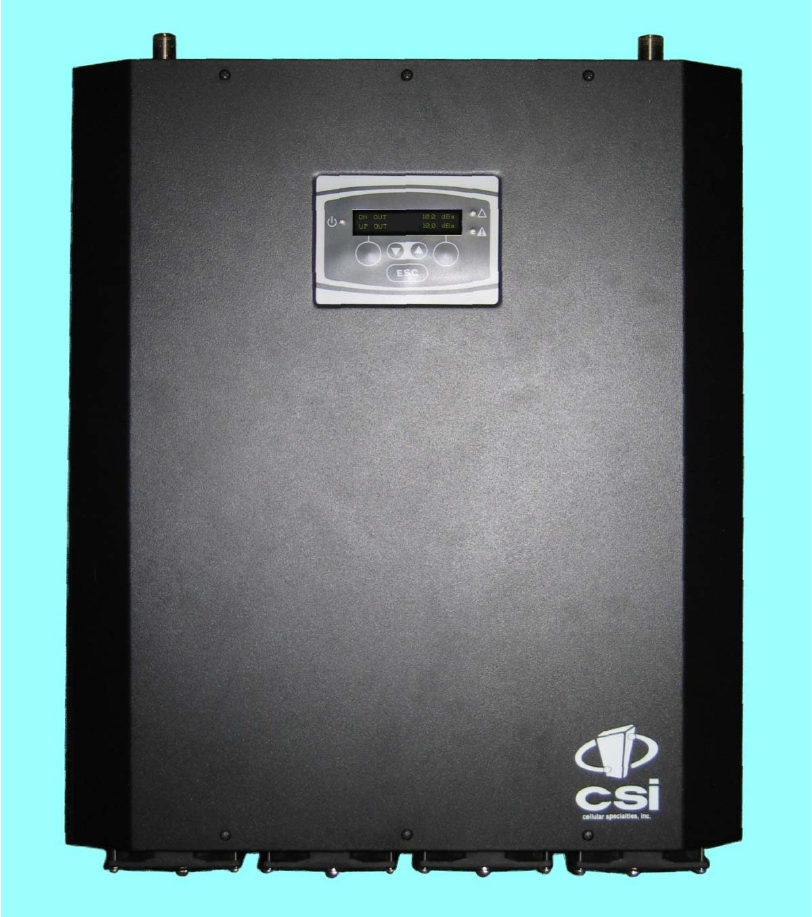
Rev 009C REVISED DOCUMENT
2/1/2007 1
CSI Wireless Engine
Digital Repeater
OPERATIONAL MANUAL
Rev 009C REVISED DOCUMENT
2/1/2007 2
Table Of Contents
Product Registration/Certification Information............... 1
Safety Guidelines .......................................................... 1
Product Description ....................................................... 2-4
LED Indicators .................................................. 3
Local Communication Interface Ports………… 3
Pin-out Chart..................................................... 4
Installation...................................................................... 6
Important Safety Information ......................................... 7
Circuit Description………………………………………… 7-12
Block Diagram…………………………………… 9
Specifications……………………………………..10-11
Mechanical Drawings…………………………….12-13
Performance Adjustment ............................................... 13-27
View Menu Series............................................. 14
View Menu Flow Diagram................................. 17
Configuration Menu Series ............................... 18
Configuration Flow Diagram ............................. 21-27
Troubleshooting............................................................. 28
Product Warranty........................................................... 29
FCC Information…..……………………………………… 29
Appendix A (Error & Control Messages) ……………….30
Appendix B (Interconnect Information) .………..…..…..31-32
Product Warranty........................................................... 41
Rev 009C REVISED DOCUMENT
2/1/2007 3
Product Certification/Registration Information
The serial number may be found on the label on the rear panel of the unit. For your convenience,
note this number below. Retain this manual, along with proof of purchase, to serve as a
permanent record of your purchase for future reference or in the event of theft.
MODEL NUMBER...................................................................SERIAL NUMBER
DATE OF PURCHASE ...........................................................POINT OF SALE COMPANY
DISCLAIMER: All information and statements contained herein are accurate to the best of the knowledge of Cellular
Specialties, Inc. (CSI), but Cellular Specialties makes no warranty with respect thereto, including without limitation any
results that may be obtained from the products described herein or the infringement by such products of any
proprietary rights of any persons. Use or application of such information or statements is at the users sole risk, without
any liability on the part of Cellular Specialties, Inc. Nothing herein shall be construed as license or recommendation
for use, which infringes upon any proprietary rights of any person. Product material and specifications are subject to
change without notice. Cellular Specialties’ standard terms of sale and the specific terms of any particular sale apply.
Document Purpose
The purpose of this document is to provide a step-by step procedure to install and commision a Digital Repeater
System. Following the procedures outlined below will minimize risks associated with modifying a live system and
preclude service interuptions.
Application
This guide should be applied whenever a need exists to add Digital Repeater capability to an existing system or when
this capability is being added simultaneously with a new installation.
Safety Guidelines
The general safety information in this guideline applies to both operating and service personnel. Specific warnings
and cautions will be found in other parts of this manual where they apply, but may not appear in this summary.
Failure to comply with these precautions or specific warnings elsewhere in the manual violates safety standards of
design, manufacture, and intended use of equipment. Cellular Specialties, Inc. assumes no liability for the customer’s
failure to comply with these requirements:
Grounding
This amplifier system is designed to operate from 120 VAC @ 3.5A max current and should always be
operated with the ground wire properly connected. Do not remove or otherwise alter the grounding lug on the
power cord.
Explosive Atmospheres
This product has an integral circuit breaker, which may cause an electrical flash if the breaker should reset. To
avoid explosion or fire, do not operate this product in the presence of flammable gases or fumes.
Lightning Danger
Do not install or make adjustments to this unit during an electrical storm.
No User Serviceable Parts Inside
HAZARDOUS VOLTAGES ARE PRESENT WHEN THE COVER IS REMOVED. Opening the chassis will
void your warranty. If you suspect a malfunction with this product, call your dealer or the Cellular Specialties
Support Line at
(603) 626-6677.
Rev 009C REVISED DOCUMENT
2/1/2007 4
Product Description
Cellular Specialties, Inc. (CSI) developed the Wireless Engine Digital Repeater for use within enclosed structures
where sufficient signal from local cell sites to operate cell phones is unavailable. Adequate signal must be available
outside the structure as a prerequisite to achieving in-building coverage. The Digital Repeater is connected to an
external antenna, usually on the roof, and to one or more internal antennas placed strategically throughout the area
where wireless services are desired.
The external antenna typically is a directional type such as a “yagi”. Internal antennas are typically omni-directional,
although various other types may be used depending on the coverage application. The Frequency Agile Repeater
(FAR) amplifies both the “Uplink” (phone to tower) & “Downlink”(tower to phone) signals thus facilitating
communications to and from the intended wireless infrastructure.
There are seven amplification stages on either the downlink or the uplink
creating a total of +85 dB nominal gain on
each link. Gain can be adjusted over a 31 dB range utilizing the local PLED display and soft switches. There are also
LED indicators near the display to indicate power overload, gain reduction, and shutdown that may be invoked by
built-in automatic protection processes.
Each amplification chain is interrupted by a specific filtering process. This process digitally converts the assigned
spectrum and then applies digital signal processing (DSP) techniques. DSP is used to create passbands that limit
the RF energy passing through either the uplink or downlink paths. After the digital processing is complete, the
information is converted back to an analog signal that is applied to the remaining stages of amplification. The
resulting signals emitted by the FAR are specific to the network service providers’ license requirements. If these
requirements change, only the DSP configuration parameters need to change in order to adapt. Configuration
parameters are created at the factory and supplied as files that may be downloaded to the FAR. The total number of
paired file parameters that can be stored within an individual repeater is limited by CPU flash memory and the
complexity of the filters. The filter set configurations stored in memory determine the unit’s adaptability to varied field
applications.
Functional Overview
The CSI-DSP85-1W repeater incorporates the following features for convenient operation,
access, protection, and control.
• Front Panel “Soft-key” Display (Power, Gain, Feature Control, Fault)
• Keypad for user feature selection
• Network Configuration and Control (Telnet/http)
• User Gain Control (affects all passbands)
• Automatic Level Control
• Automatic Power Control (rev 2.0)
• Oscillation Protection
• Over Drive Protection (P.A. limiting)
• Under/Over Voltage Protection
• Low Gain detection on PA (rev 2.0)
• Fault protection (rev 2.0)
• Alarm Notification – Local
• Fan speed and temperature control (automatic)
• Upgrade Support – local
• External Interfaces: USB/Ethernet/Serial
• Field Re-loadable filters (local)
• Web-based monitoring and control - local/remote (rev 2.0)
• Persistent Status and Error information
Rev 009C REVISED DOCUMENT
2/1/2007 5
LED Indicators
Automatic safety precautions are built into the amplifier system. As a catastrophic response, a
shutdown circuit is incorporated that will effectively disable all emissions should the uplink or
downlink be overdriven or should an oscillation event occur. The amplifier will periodically attempt
to recover from the detected condition based on time and various system measurements
performed automatically. Warning light indicators are as follows:
Warning: Indicated by a yellow LED. The unit has sensed instability due to insufficient
isolation between the inside antenna and the outside antenna, and has reduced
the gain of the amplifier. This is done to prevent oscillation, which can interfere
with the handsets in the covered area and/or the wireless service provider’s base
station. Also an indication of additional minor fault events defined in the Display
Events menu.
Fault: Indicated by a red LED. The gain of the unit has been reduced to a minimum in
order to prevent very strong input signals from overloading the amplifier. The
amplifier will attempt to recover from this condition, initially at fifteen-second
intervals and then at four-minute intervals. This is also an indication of a major
fault.
Power: Primary power is indicated by an illuminated green LED. The repeater is not
equipped with an ON/OFF power switch.
As described previously, various automatic safety precautions are built into the amplifier system. As a catastrophic
response, a shutdown circuit is incorporated that will effectively disable all emissions should the uplink or downlink be
overdriven or should an oscillation event occur. The amplifier will periodically attempt to recover from the detected
condition based on time and various system measurements performed automatically.
Local Interfaces
To facilitate monitoring and control, the FAR is equipped with four ports that provide external communication access
(2 DB-9 serial, 1 USB, and 1 Ethernet). One serial interface provides communications to a local PC and the second
to an external modem. The USB interface provides a means to download files from a memory device. Ethernet is
provided as an optional communications port to the PC in lieu of serial communications. The DB-9 pin assignments
conform to the standard Electronic Industries Association (EIA232) specification. A diagram of the pin descriptions is
provided for reference follows.
Communication to the control processor’s Command Line Interface (CLI) is facilitated by connecting a null modem
cable to Com 1 and using a terminal emulation program with any PC. No login is required, however, functions are
severely limited. See Appendix B for additional information.
Pin descriptions for a DB25 are also provided as part of appendix B in the event adaptation is required for interface to
a unique application.
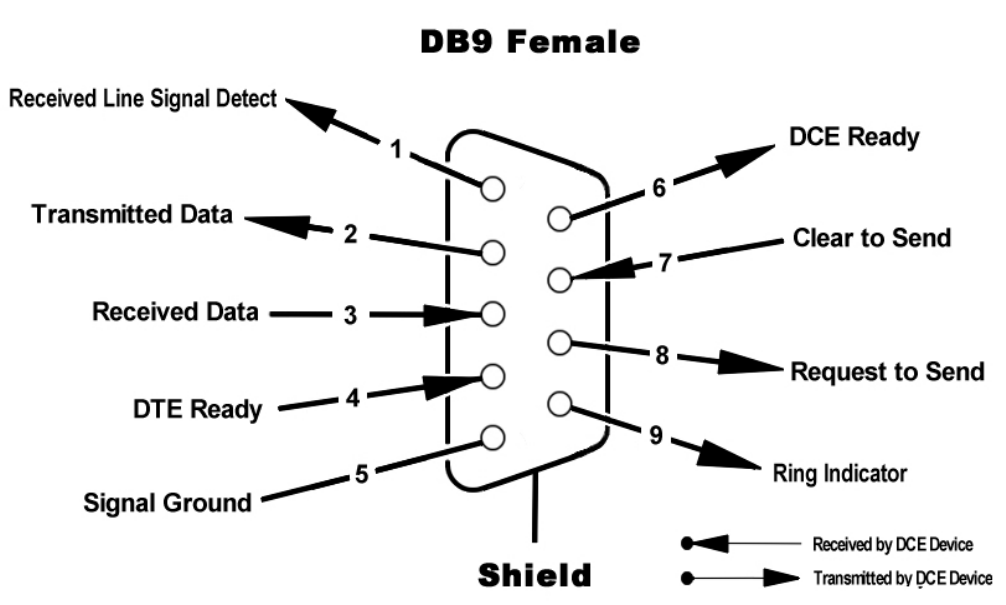
Rev 009C REVISED DOCUMENT
2/1/2007 6
EIA232 Pin Specifications
USB Interface
The Universal Serial Port (USB) interface conforms to Intel’s Universal Host Controller Interface (UHCI) version 1.1
dated March 21, 1996. This interface will support data transfer rates up to 12 Mbps.
Ethernet
The Ethernet AUI conforms to IEEE 802.3 and is capable of supporting 10/100 Mbps
communication speeds.
Monitoring & Alarms
There are no physical connections provided to specifically communicate system states or alarm status. This
information is imbedded in data accessible via the communication ports described earlier.
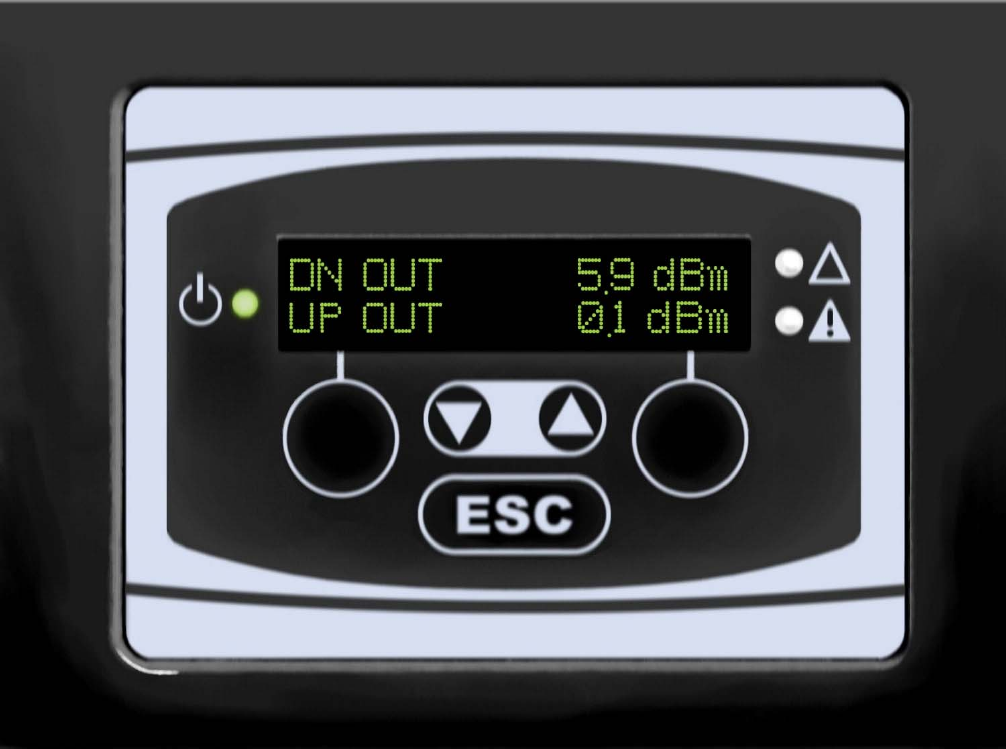
Rev 009C REVISED DOCUMENT
2/1/2007 7
Polymeric Light-Emitting Diode (PLED) Display and Keypad
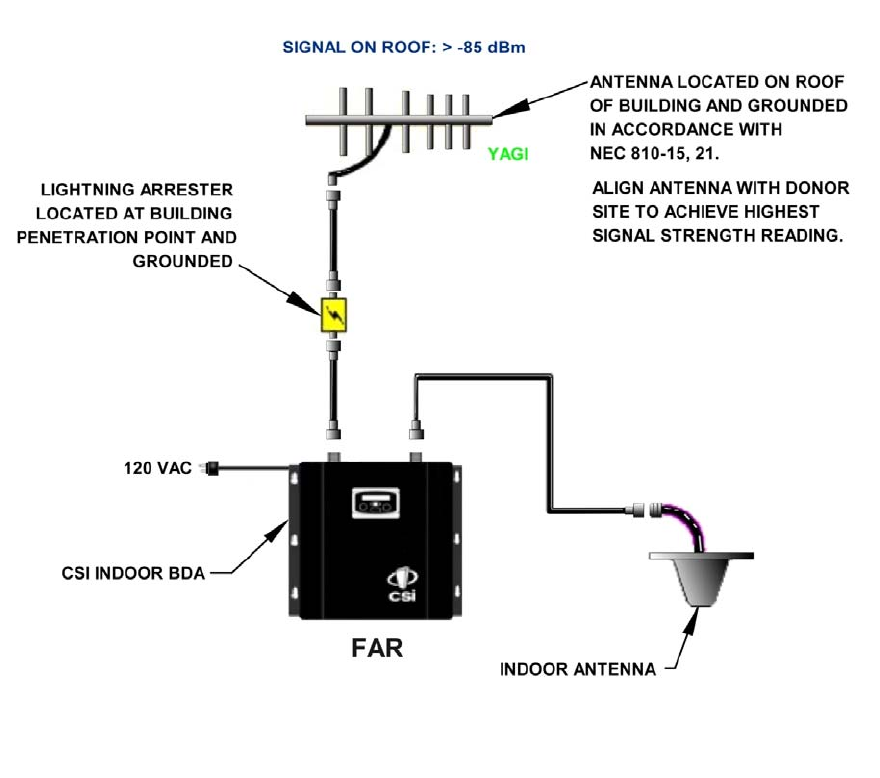
Rev 009C REVISED DOCUMENT
2/1/2007 8
Installation:
Example: Standard Single Internal Antenna System Design
Optional Accessories
Accessories are available directly from Cellular Specialties, Inc. or any of CSI’s distributors.
• Outside Gain Antenna
PCS – model number (Tessco Part No. 59090)
SMR/CELL – model number (CSI – AY 806-960)
SMR/CELL – model number (Yolycom YLGP 08/09-12)
• Inside Omnidirectional Antennae
PCS – model number (CSI-AS/1.85-1.99/2)
SMR – model number (CSI-AS/806-866/4)
Tri-Band – model number ( CSI-AO/800/2.5K/3)
• Power Dividers
2:1 - model number (CSI-S2BSC)
3:1 - model number (CSI-S3BSC)
4:1 - model number (CSI-S4BSC)
• Grounding Kit - model number (CSI-GKIT)
• Lightning Arrestor - model number (CSI-CAP)
• Directional Couplers and Cross Band Couplers are also available
Rev 009C REVISED DOCUMENT
2/1/2007 9
Important Installation Notes
• Inadequate isolation between the outside and inside antennae may cause re-generative feedback in the system.
Without a detection and control mechanism, feedback can cause the amplifier to emit a continuous signal at
maximum amplitude and, in some cases, interfere with normal operation of the cell site. Careful consideration of the
layout and placement of the system is imperative.
• The Installer should refer to the Safety Precautions, in the following section, for proper antenna selection and
installation
WARNING! AMPLIFIER OR HANDSET DAMAGE MAY OCCUR IF A HANDSET IS
CONNECTED DIRECTLY TO THE REPEATER OR THE COAX THAT LEADS TO THE
REPEATER.
Important Safety Information
Antennae used for the purpose of radiating signals indoors are limited to a maximum gain of 3
dBi. The outdoor antenna used for the purpose of communicating to the wireless infrastructure is
limited to 14 dBi gain, or any combination of gain and loss the equates to 14dB at input. Each
antenna must be positioned to observe minimum separation requirements from all users and
bystanders. The following guidelines should be used when considering separation distances.
INDOOR antennae must be placed such that, under normal conditions, all personnel cannot
come within 20 cm. (~ 8.0 in.) from any inside antenna. Exceeding this minimum separation will
ensure that the employee or bystander cannot exceed RF exposures beyond the maximum
permissible limit as defined by section 1.1310 i.e. limits for General Population/Uncontrolled
Exposure.
The OUTDOOR antenna must be positioned such that, under normal conditions, all personnel cannot approach
closer than 120 cm. (~ 4 ft.). If a directional antenna having a maximum gain of 14 dBi is used, precautions should be
taken to prevent personnel from routinely passing through the main radiation beam at a distance closer than
specified.
Circuit Operational Description
The repeater uses a single down-conversion/up-conversion scheme (see Figure 1). There are
three RF amplifier stages prior to each down-converting mixer. The down-converting mixers are
followed by a single IF amplifier. A Digital Signal Processor block then processes the resultant
digitized IF signal that was previously generated by an Analog-to-Digital Converter. The
processed (filtered) digital signal is fed to a Digital-to-Analog Converter and then up-converted to
RF. A driver amplifier and a final power amplifier make up the final gain stages before application
to the diplexer. The maximum total system gain (diplexer input to diplexer output) is nominally 85
dB for either the downlink or the uplink paths with both links having independent manual and
automatic gain controls (AGC).
AGC reacts to analog power detection on both the input and output of the uplink and downlink RF
chains. A control algorithm continuously monitors these detected values and dynamically adjusts
various gain stages such that the net system gain value, entered manually, is maintained without
either exceeding FCC parameters or overdriving the A/D converters.
Rev 009C REVISED DOCUMENT
2/1/2007 10
LEDs on the top panel provide immediate visual indications of the unit’s primary power and major
or minor alarm status. The repeater features automatic shutdown protection as a safety measure
should excessive drive be applied to the input or an oscillation condition occur. When in a
protected mode, a control algorithm determines the appropriate method of recovery to a normal,
previously defined state, or maintains the protection until manually reset. If recovery has been
established, the associated LED(s) will either be extinguished or available to be reset.
Digital signal processing is performed concurrently on the complete spectral band allocation.
Therefore, in the case of the US PCS band, digitization of 60 MHz (Up or Down links) is first
accomplished. Next, coefficients are applied to a mathematical algorithm that has been
established in a specialized Field Programmable Gate Array (FPGA) processor. These
coefficients, stored in memory, initiate the algorithm calculations needed to form Start and Stop
bands, roll-off, passband flatness, and other characteristics of the entire digitized signal.
Performance tradeoffs are made based on the finite computational power of the FPGA and the
necessary operational requirements.
Coefficients used in the DSP process are stored in non-volatile memory and recalled when a filter
set is required. Two filter sets are quickly accessible from EEPROM while the remaining are
stored in flash memory. The two sets stored in EEPROM can be interchanged in less than 2
seconds. Depending on the size of the coefficient files, replacing EEPROM files with files stored
in flash memory takes approximately 2-3 minutes.
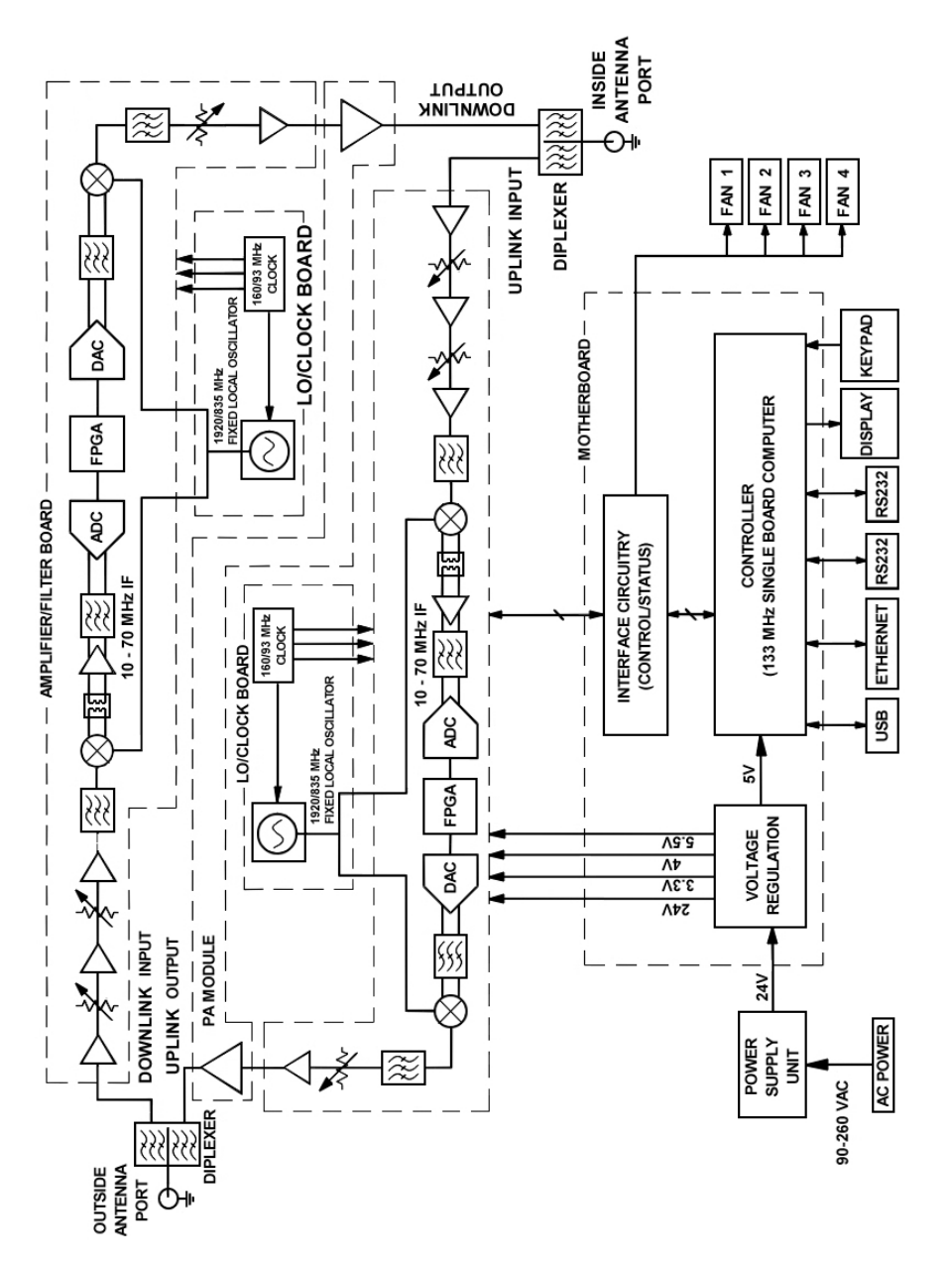
Rev 009C REVISED DOCUMENT
2/1/2007 11
Fig. 1 Functional Block Diagram, Model DSP 610
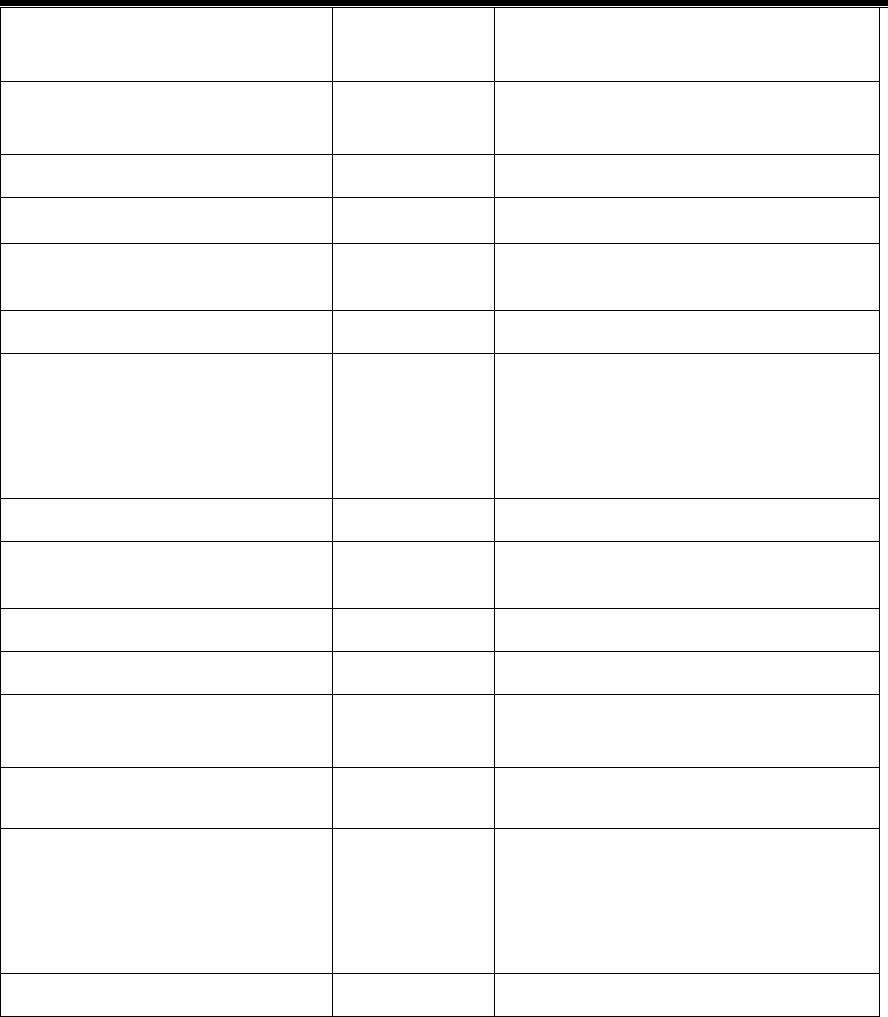
Rev 009C REVISED DOCUMENT
2/1/2007 12
Specifications
Parameter Specification Notes
Maximum RF input Power
without damage
+10 dBm .
Nominal Gain 85 dB
Factory Calibrated Gain
Gain Flatness +/-2.0 dB (+/- 1.0 dB typical)
Gain Stability +/-1.0 dB Gain vs. Temperature
Automatic Level Control (ALC) 31 dB max
range
In 0.5 dB steps
Manual Gain Control 55-85 dB max In 0.5 dB steps
Minimum Composite Output
power
PCS/UMTS
SMR/Cell
+27 dBm
+30 dBm
Uplink and Downlink
Noise Figure 5.0 dB max At Maximum gain
OIP3 45 dBm Measured with 2 CW tones at 14
dBm/tone
RMS Vector Error (EVM) 3% max TDMA, EDGE, W-CDMA, CDMA2000
CDMA RHO 0.98 min CDMA 2000,1x-EVD0
Group Delay 2.5 usec max Typical delay when 400 tap
filter implemented; < 2.5 usec.
VSWR 2:1 max (1.5:1 typical)
Spurious Emissions &
Applicable Documents
FCC
Industry Canada
-13 dBm max
-13 dBm max
Per FCC part 2, 20,24 & 90
Per UC RSS 131
Operating Power Parameters
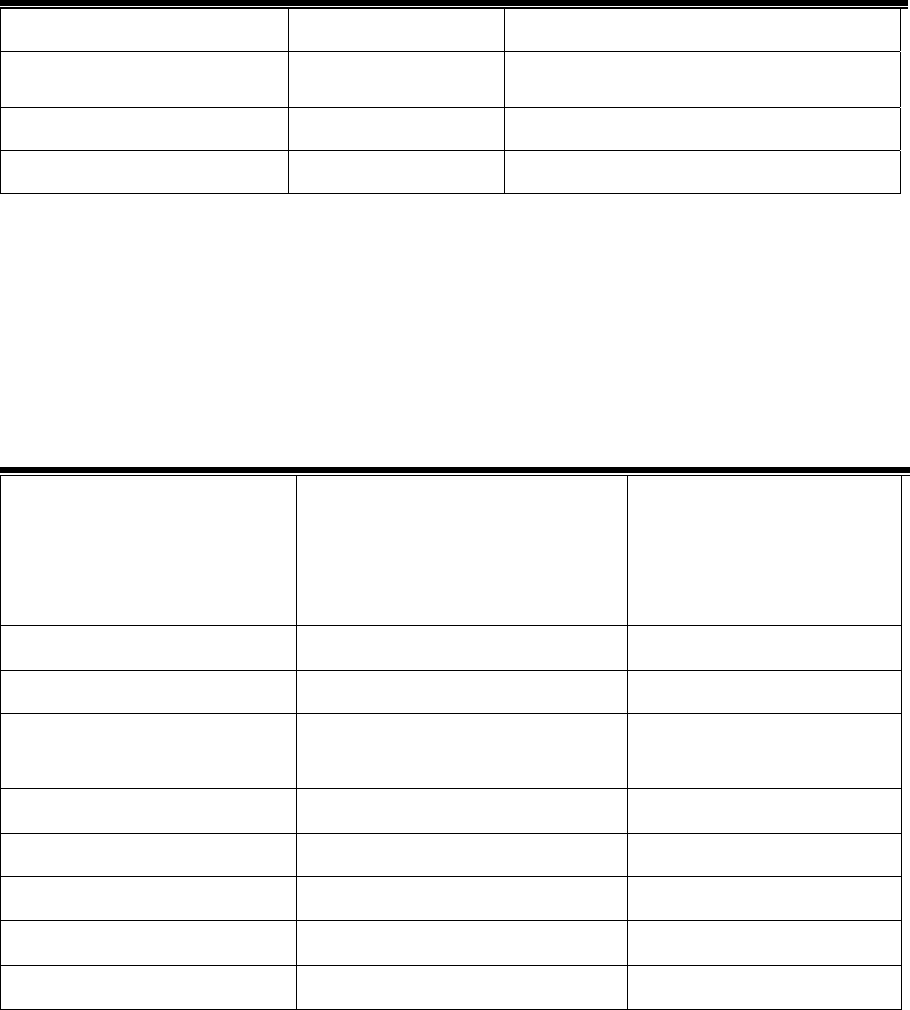
Rev 009C REVISED DOCUMENT
2/1/2007 13
Parameter Specifications Notes
AC Voltage 85 – 264 VAC Specification SP-200-24
AC Current 3.5 Amps
1.7 Amps
@ 115 VAC
@ 230 VAC
AC Power Frequency 47 – 63 Hz
Power Consumption 285 Watts (Max)
Parameter Specifications Notes
Box size
Height
Width
Depth
9.117 in.
15.12 in.
18.5 in.
Box weight 27.5 / 12.5 lbs/kg
Mounting Brackets Description needed
Box Thermal Management External Air 4 Variable speed fans
Temperature controlled
Surface Coating Powder Coating
Color Sherman Williams #____ Satin Black
Label See Label Diagram
Battery Backup None
Acoustic Emission N/A
AC Power Specifications
Mechanical Specifications
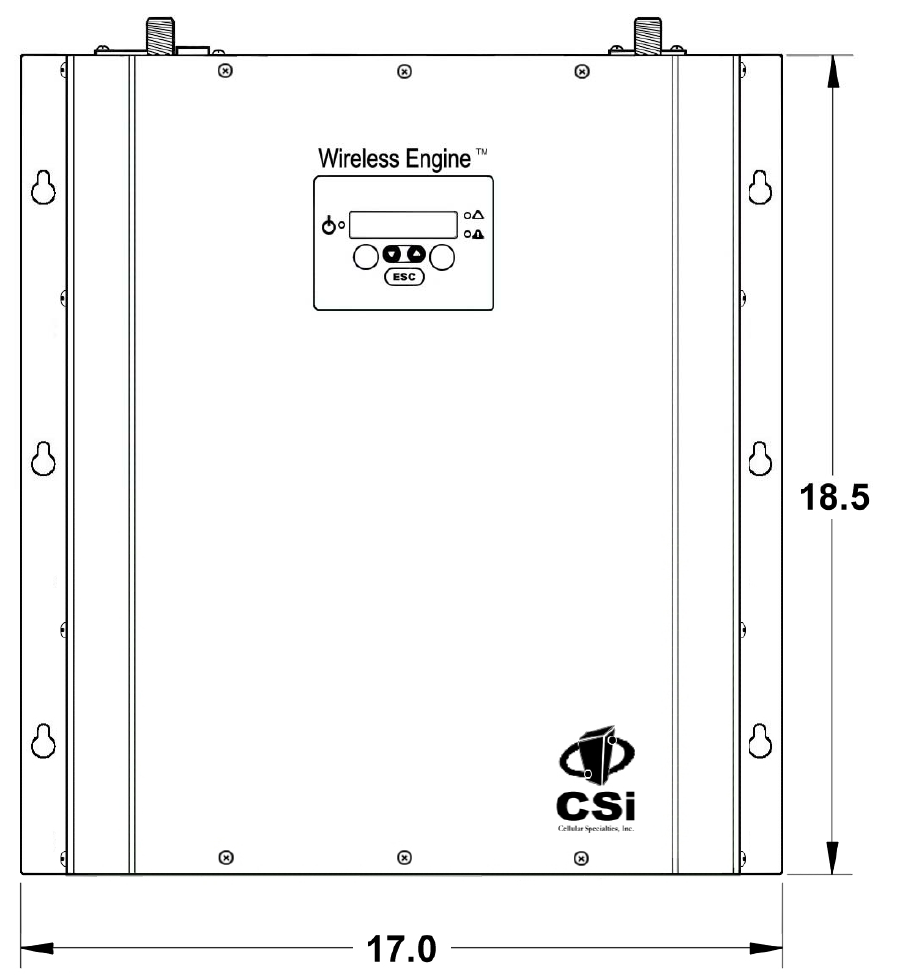
Rev 009C REVISED DOCUMENT
2/1/2007 14
Enclosure Drawings
Figure 1 Mechanical Drawing - Front
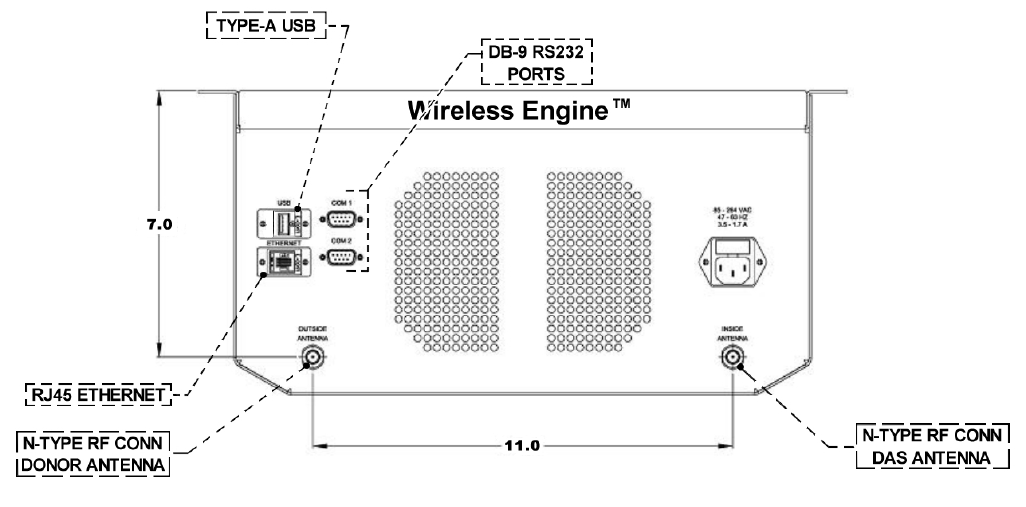
Rev 009C REVISED DOCUMENT
2/1/2007 15
Mechanical Drawing - Top
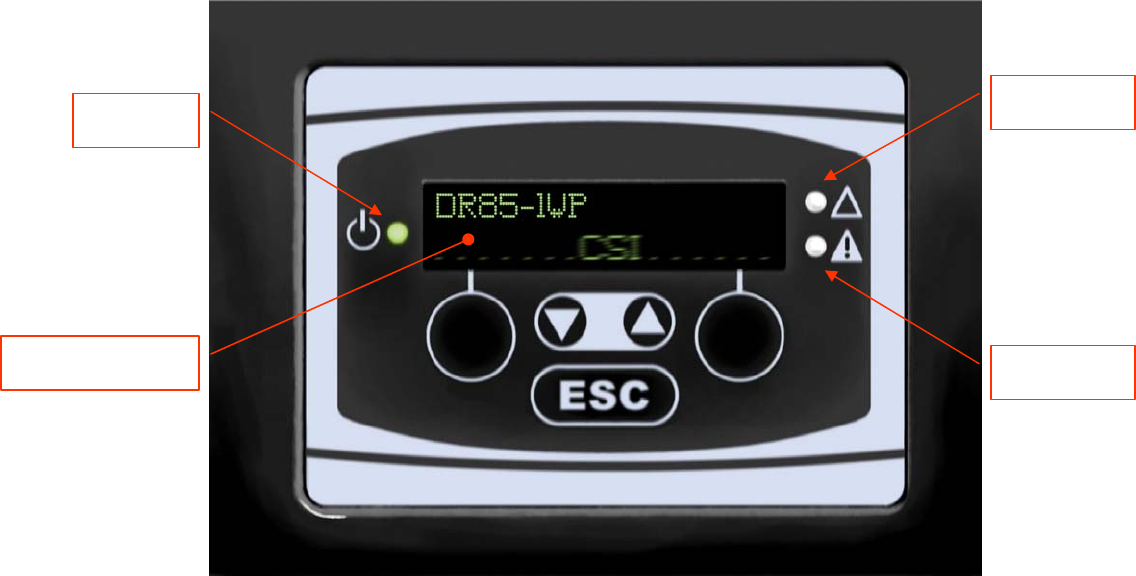
Rev 009C REVISED DOCUMENT
2/1/2007 16
Performance Adjustment
Keypad System
The performance menu system can be navigated with five keypad buttons: UP, DOWN, SOFT
KEYS, and ESC as shown above. There are two soft keys located either side of the UP/DOWN
keys which have functional assignments based upon the menu option being displayed. Feedback
is given to the operator through the PLED display panel used to form an information window.
A Screen Saver mode is the default display and also shown above. After a period of keypad
inactivity, or when forced, the screen saver will become active. The purpose of this mode is to
provide an immediate view of a unique, user settable device ID. This ID is displayed on the top
line. The next line will display a scrolling “CSI” logo. The mode is also an indication that the
configuration function is locked.
Accessing the repeater command Interface is accomplished by pressing any key on the pad after
which the first menu series will be presented. This Screen Saver display mode is available as
part of version 2.0 or higher firmware.
Menu Scheme
The menu scheme presents information via a standardized window layout. When appropriate,
the window also contains soft key designators that either allow configuration changes to be
executed or provide access to additional information. The most needed information is kept
toward the top of the menu scheme forming a Menu Series hierarchy based on the most
frequently viewed data or executed functions. In any menu series, continually pressing the UP or
DOWN arrow buttons will move the display through the complete set of display windows after
which the user will loop to the top or beginning of the menu (see the menu series flow charts as
an example)
Primary
Power LED
Warning Event
Yellow LED
Critical Event
Red LED
FACTORY DEFAULT
SCREENSAVER
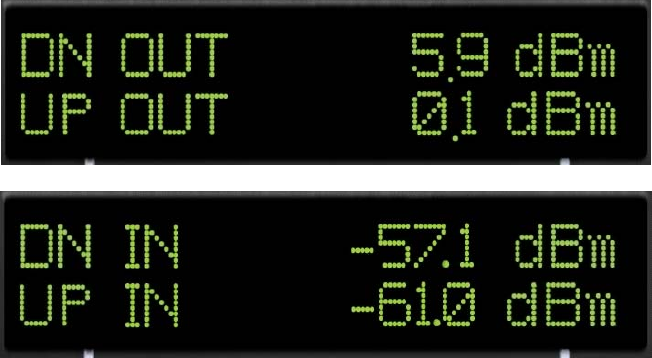
Rev 009C REVISED DOCUMENT
2/1/2007 17
The purpose of the initial menu scheme is to provide a quick overview of current system settings
and values. The View Menu Series flowchart presented on the next page outlines the sequence
of this information. Notice that no soft keys are available while in this menu loop.
View Menu Series
Content of the view menu series is described below along with an example snapshot of the actual
window displayed. A high level overview is provided as an explanation of the function(s) offered
through the window.
Power Displays
Selecting a DOWN or UP arrow repeatedly will scroll forward or backward thru current system
information. Pressing ESC will transition between the View Menu and Configuration Menu series.
Therefore, if the observed power levels are not acceptable, adjustments can be made after
pressing ESC and unlocking adjustment configuration capabilities by successful password entry.
The first data displayed after exiting the Screen Saver is the downlink and uplink output power
levels associated with the current outdoor and indoor environments. The displayed values are
the power emitted in dBm toward the cell site on the uplink and toward indoor mobile equipment
on the downlink as referenced to the respective RF port.
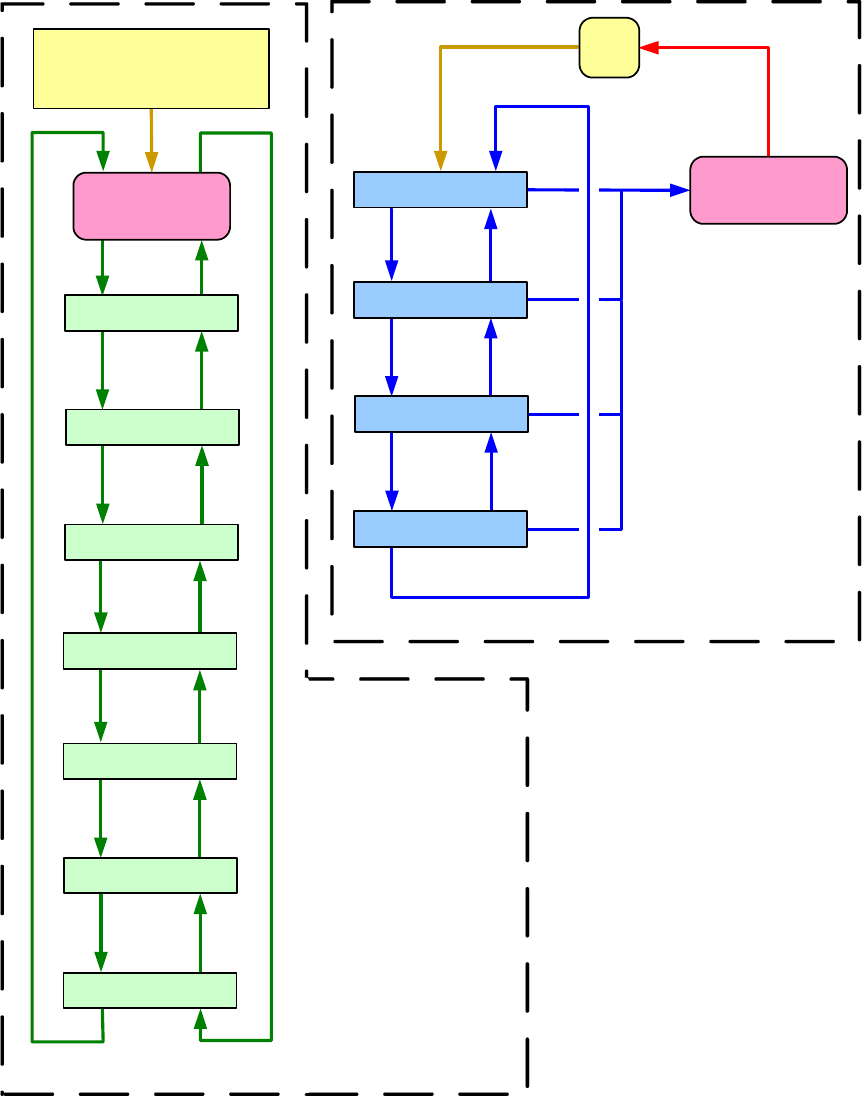
Rev 009C REVISED DOCUMENT
2/1/2007 18
View Menu Series Configuration Menu Series
ESC
Output
Power
Show Config.
Down Up
Down Up
Down Up
Enter Password
Right
Right
Right
Right
Show Events
Show I.D.
Pressing ESC in
any of these
menus will take
you to Output
Power
Down Up
Down Up
Down Up
Filters
Input Power
Last Oscillation
Last Overrange
Gain
Goal Power
Down Up
Down Up
Down Up
Down Up
Exit from Config.
And Password Unlock
Selections
POWER DISPLAY
Last Overheat
Pressing ESC in any of
these menus will take
you to Show Config.
The LEFT and RIGHT
softkeys have no effect
in any of these menus
Output
Power
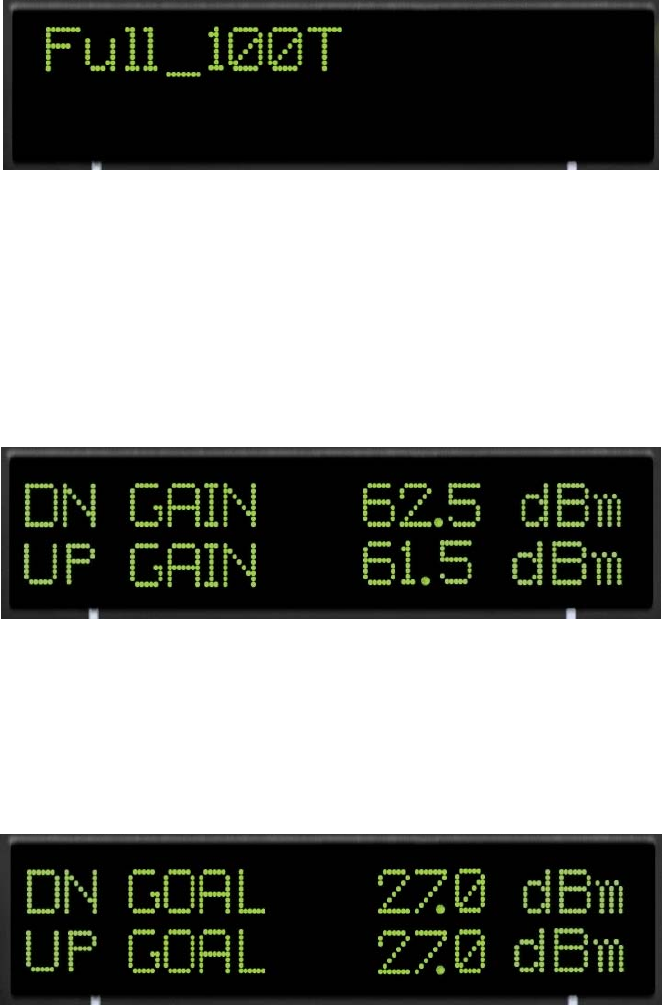
Rev 009C REVISED DOCUMENT
2/1/2007 19
Filters
The filters display shows the filter currently in use by the FPGA and stored in the EEPROM as
either filter #1 or #2. Selecting the opposite filter from the FPGA will invoke that new
configuration. Filters are given meaningful names to the extent possible. In the example above,
“Full_100T” implies full spectrum using 100 DSP filter taps.
GAIN
The gain represented in this view menu screen represents net system gain in the downlink or
uplink paths as selected from the configuration menu. It is adjustable in 1 dB steps from within
the Config Menu Series but may be indicated with greater resolution (0.1 dB) because of internal
adjustments made automatically.
Goal Power
Goal Power represents the power goal set by a selectable option.
If constant power is selected, then the system will attempt to maintain the indicated power level
so long as internally stored constants are not exceeded. This option is not available as part of the
current firmware release.
If constant power is not selected (default method), then the displayed Goal Power is equal to the
maximum permissible repeater output power as displayed in the example window above. As
established by a fixed gain setting and link budget, AGC will not allow the output power to exceed
the Goal Power (repeater limitations) but will allow the signals to fall below the displayed goal.
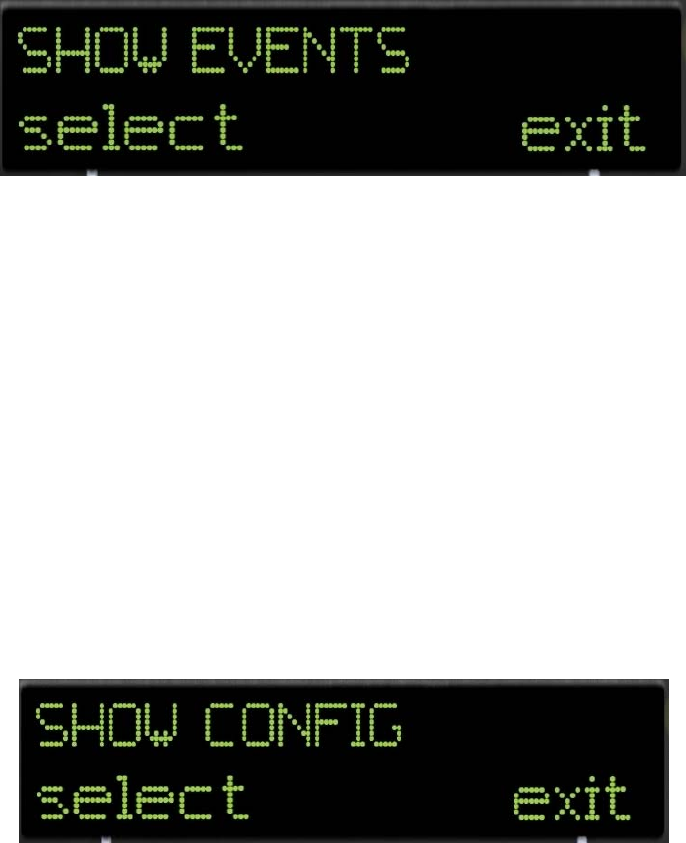
Rev 009C REVISED DOCUMENT
2/1/2007 20
Current Event
An overrange event is an indication of either uplink or downlink A/D converters being overdriven.
The displayed window will indicate a date and time when the event occurred, or if no event
occurred, indicate that condition as well. While the event is occurring, a red LED will illuminate
and extinguish automatically after the event has ceased. The yellow LED will remain illuminated
until reset from within the configuration Menu.
The last event can be reset from within the Display Events window described later in the
configuration Menu Series.
This function is not implememented in the current release of firmware.
Configuration Menu Series
Pressing ESC from within the View Menu Series places the user in the configuration menu
series. The first window to be displayed is Show Config. Similar to the view menu series, using
the arrow keys will continually scroll the menu items. At any one of the menus within the loop, if
sub-menus exist, a soft key will be defined above the key. Selecting the Left soft key will provide
additional menu choices while selecting the right soft key will return to the Show Config window
at the top of the series. Pressing ESC at any point in the menu system will return to the View
Menu Series.
Content of the Configuration menu series is described below along with an example snapshot of
the actual window displayed. A high level overview is provided as an explanation of the
function(s) offered through the window.
Show Config
Pressing select from the Show Config window will display a year-date time group stored in the in
the CPU. Pressing exit will return to the main Show Config Screen.
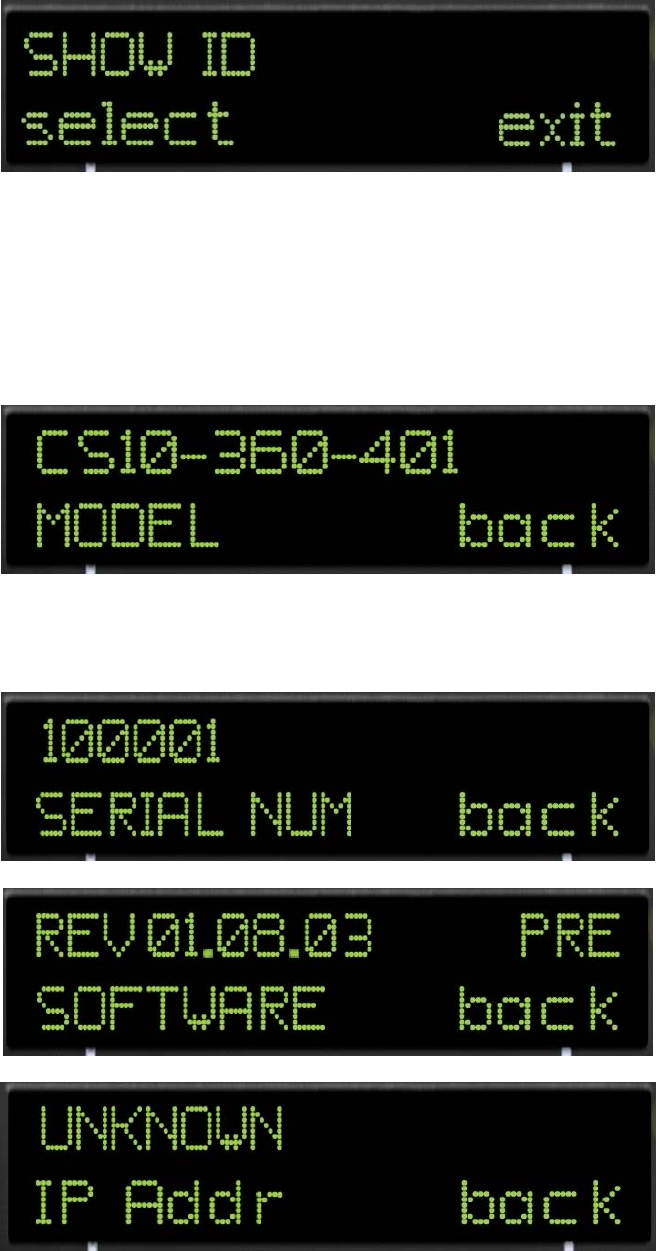
Rev 009C REVISED DOCUMENT
2/1/2007 21
Show ID
The show ID set of sub-menus is designed to access specific information about the device.
Pressing select from within the this screen will allow access to model, serial number, software
version, & IP address.
The following windows show the format of this sub-menu information:
The displayed number represents CSI’s internal item number.
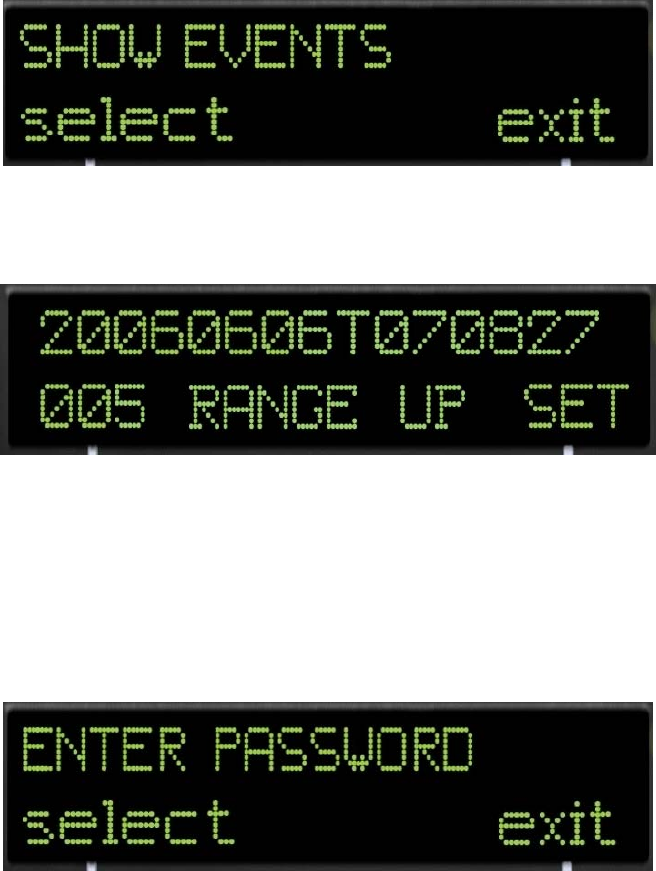
Rev 009C REVISED DOCUMENT
2/1/2007 22
.
Display Events
The Show Events window will allow access to more information about events that have triggered
an alarm and set the yellow front panel LED to “ON”. The yellow LED can be reset from within
the sub-menu shown below.
The event that triggered the alarm will register a date-time group, specify the exact event and link,
and allow it to be reset by scrolling through and viewing the event. Pressing the SET Soft Key
will return to the Show Events window and simultaneously reset the yellow warning LED. In the
event provided as an example above, an overrange occurred in the uplink. See appendix A for
list of the possible event displays. (Note: during a fan failure event, DN indicates the left two fans,
and UP indicates the right two fans).
Enter Password
Editing cannot be made to the repeater configuration without successfully entering a password.
When the wrong password is entered a password error screen will appear. The Screen will say
“PASSWORD ERROR” and offer a “retry” soft key.
The password is based on a sequence of UP DOWN and SOFT KEYS. The default key
sequence as provided from the factory is:
1. Left SOFT KEY
2. Right SOFT KEY
3. UP ARROW
4. DOWN ARROW
If the password is entered successfully, a window will appear that says “PASSWORD OK” and
offers two options via Soft Keys, “lock” and “unlock”. Pressing unlock will place the authenticated
operator into the first screen that can be edited.
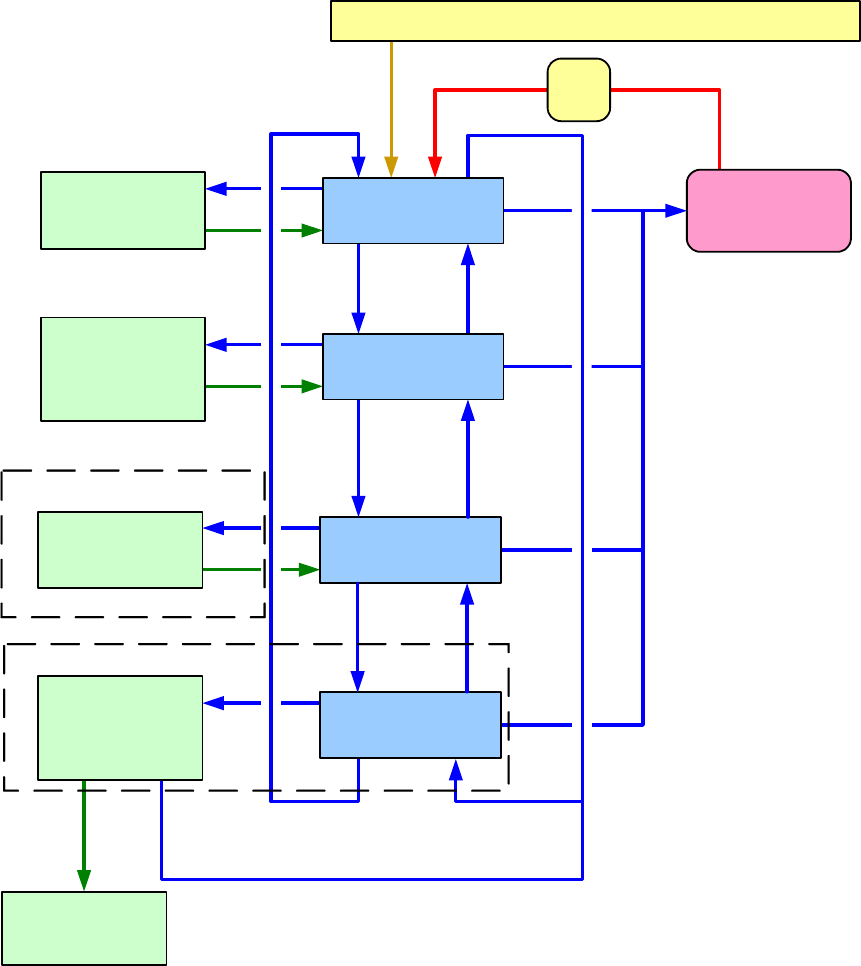
Rev 009C REVISED DOCUMENT
2/1/2007 23
Display
Time
Select
Back Exit
To:
Display ID
Selections
Select
Back
Display
Events
Select
Set
Select
ESC from Password Unlock Selections
UpDown
Show Events
Output
Power
UpDown
Show ID
Enter Password
Show Config.
UpDown
Exit
Exit
Exit
Unlock
With Correct
Password
See Enter Password Selection
ESC
Enter
Password
L,R,U,D
View Menu
Select
Auto Clear
CONFIGURATION SELECTIONS
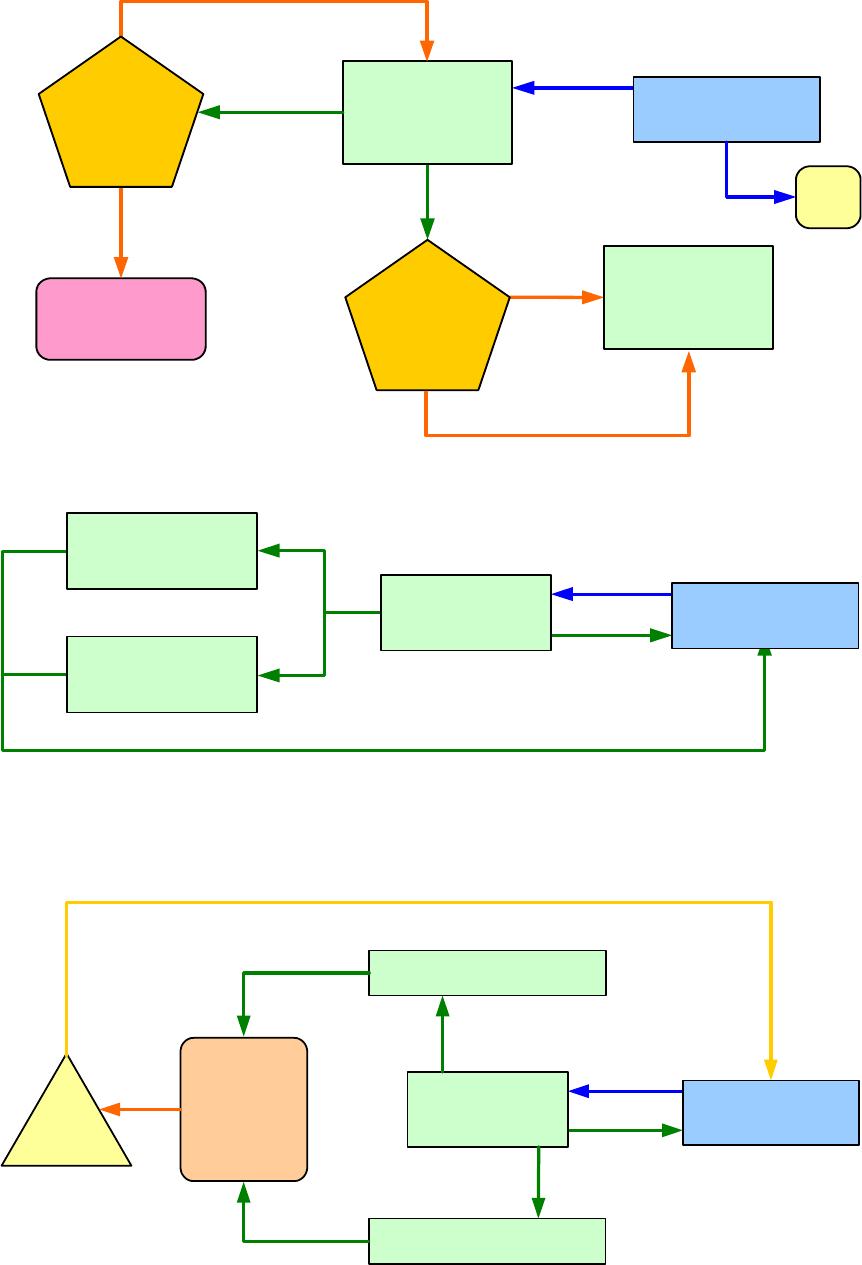
Rev 009C REVISED DOCUMENT
2/1/2007 24
Select
Output
Power
Enter Password
Unlock
With Correct
Password
Enter
Password
L,R,U,D
ENTER PASSWORD SELECTIONS
Yes
No
RETRY?
Incorrect
Password
Select
Back
TOGGLE FILTER SELECTIONS
Filter is __ Filter 1 or 2
Load filter #2
Load filter #1
Lock or
Unlock?
View Menu
Select
Yes
No
ESC
PROGRAM FILTER SELECTIONS
Load Filter
Select
Back Program Filters
Program Filter #1
Program Filter #1
List of
Choices
Load
Select
Select
Select
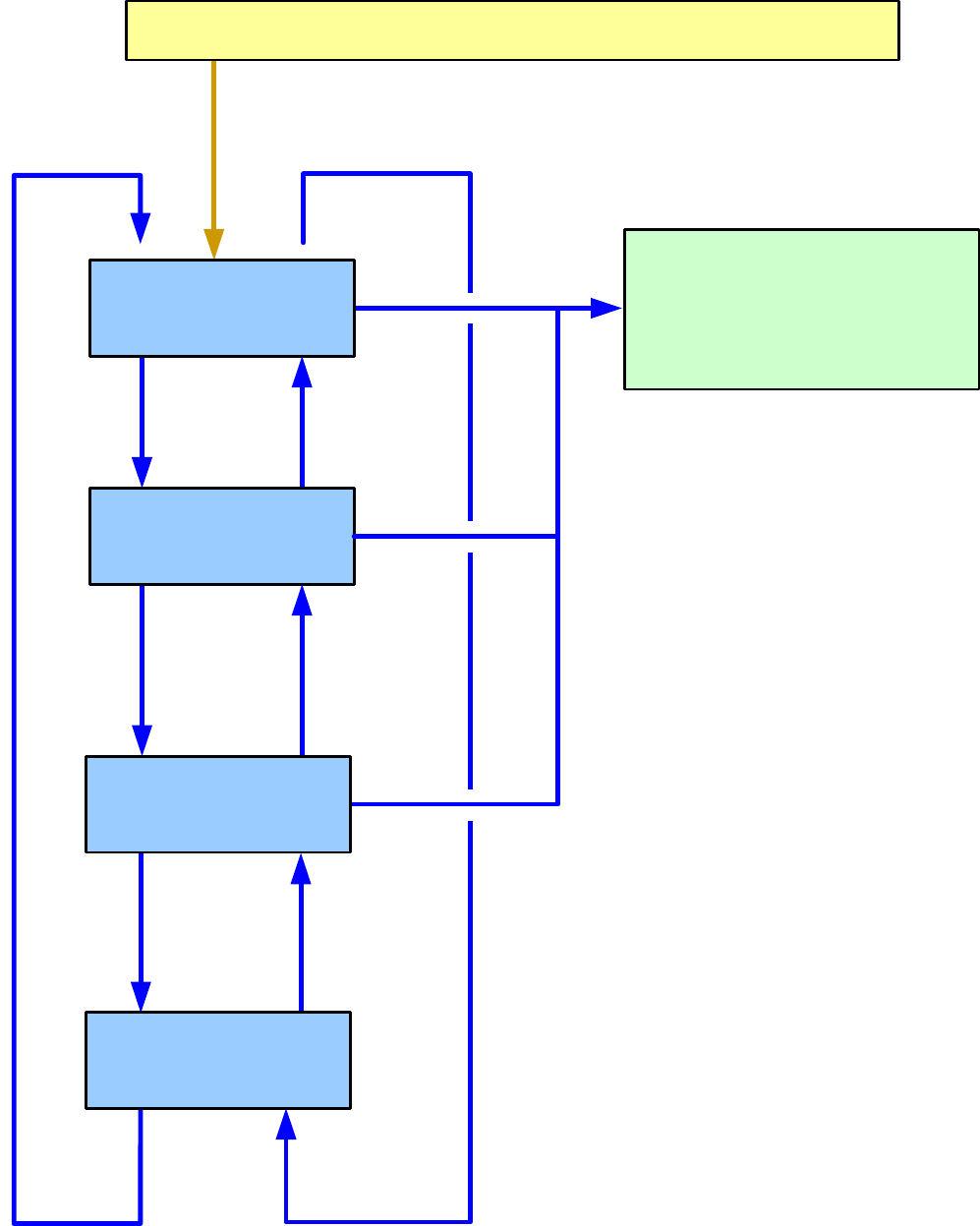
Rev 009C REVISED DOCUMENT
2/1/2007 25
Back
Select in Show I.D. Config. Selection
UpDown
UpDown
Serial Number
UpDown
Back
Back
DISPLAY I.D. SELECTIONS
To show I.D.
Config. Selection
Up
Up
Model Number
Software
Version
IP Address
Down

Rev 009C REVISED DOCUMENT
2/1/2007 26
Editing Configuration Parameters
User Downlink Gain
The User Downlink Gain Adjust has a range of 30 db in 0.5 dB steps. Access to this adjustment is enabled through
the “select” Soft Key. The adjustment window will display “UP GAIN” and the current gain setting in xx.x dB format.
Use the UP or DOWN arrows to change the current gain setting by incrementing the least significant digit. When the
desired setting is displayed, press the “done” Soft Key to set the value and return to the User Downlink Gain window.
Setting the downlink value will likewise set the uplink value to be the same. If the links must be unbalanced (different
values), set the uplink value last. Changing the uplink value will not change the downlink value.
User Uplink Gain
The User Uplink Gain Adjust window is manipulated similarly as the downlink. It is important to remember that
changes made in this window will not alter the values of the downlink. The reverse is not true.
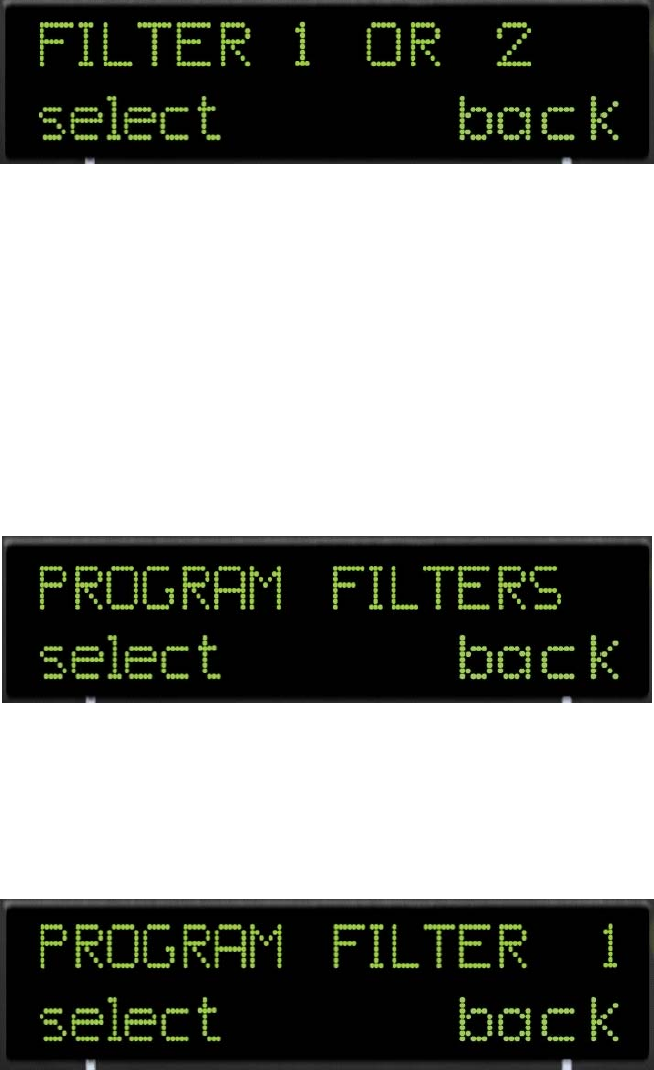
Rev 009C REVISED DOCUMENT
2/1/2007 27
Filter #1 or #2
Filter 1 or 2 window allows the filter coefficients stored in EEPROM memory to be manipulated into an active or
standby state. The time for this operation to occur is roughly 1-2 seconds. Pressing the “select” Soft Key will display a
window that indicates which filter is active, e.g. “FILTER IS #2” or “FILTER IS #1”. A Soft Key, “load #1” or load #2” is
presented in the window that will allow the active filter to be toggled with the standby filter. If different filters are desired
other than the active or standby sets, it must be uploaded from flash memory. This process takes 2-3 minutes if the
coefficients exist in flash memory. If the coefficients do not exist in flash memory, then they can be uploaded through
the USB port. Coefficients must be produced at the factory.
Program Filters
The Program Filters window will allow new filter coefficients to be uploaded from flash memory. Pressing the “select”
Soft Key will display the following sub-menu.
Using this window will allow the selected filter number to be replaced by new coefficients. If either the UP or DOWN
arrow is pressed, the filter number will toggle between “1” or “2”. After the correct number is established, pressing the
“select” Soft Key will display all the choices available within flash memory. When the desired choice is displayed,
pressing the “select” Soft Key once again will begin the process of uploading new filter coefficients into the filter
number location chosen earlier. A Red LED, which will extinguish at the end of the process, indicates the uploading
state is complete.
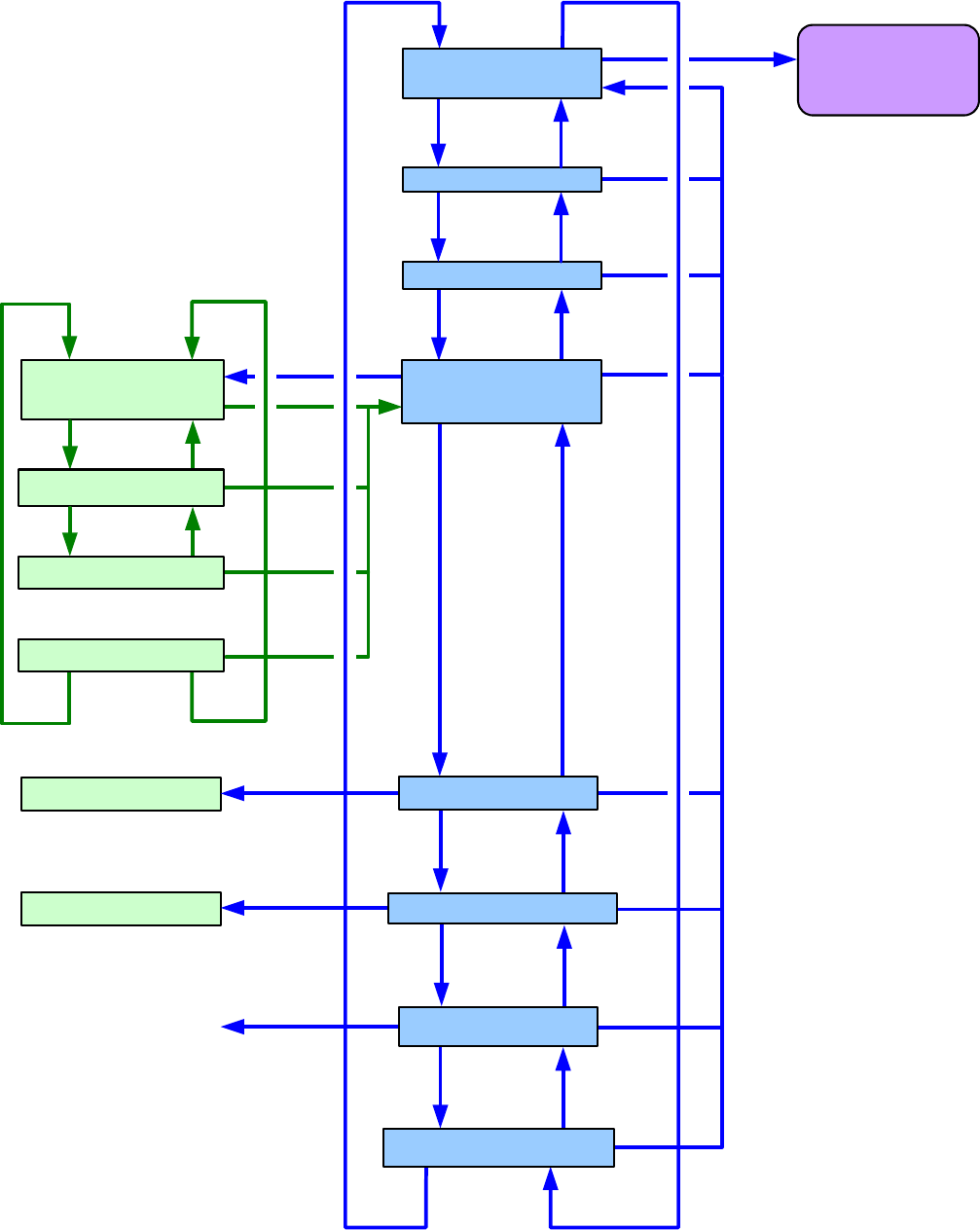
Rev 009C REVISED DOCUMENT
2/1/2007 28
Up/Dn
Output Power
Select
Back
Idle
Message
Exit
Down
Back
Back
Back
Back
Back
Back
Up
Up
Down
Up
Down
Up
Down
Up
Down
Edit Config.
Enter Password
Up
Down
Show I.D.
Up
Down
Down Up
USB Upgrade
Select
P.A. Output On
Select
P.A. Output CTRL
Select
Shutdown System*
Down
Toggle Filter
Show Config.
Up
Down Up
Down Up
Up/Dn Gain
Reboot System
System Upgrade
Unit re-boots
(takes 5 mins.)
Back
Back
Back
* System shutdown will terminate entire BDA
service.
Power cycling at the BDA is required to restore
BDA operation.
Show Events
PASSWORD UNLOCK SELECTIONS
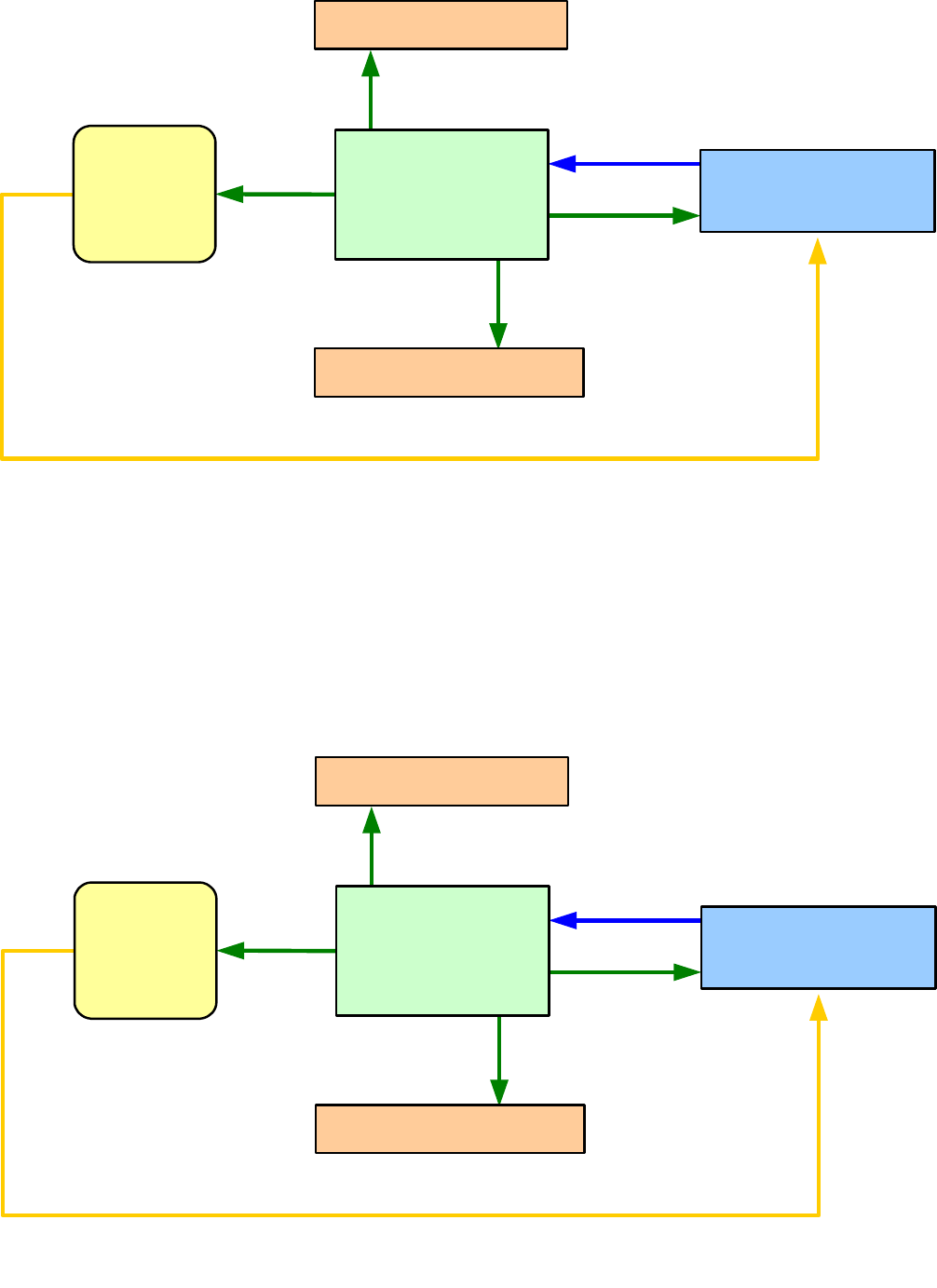
Rev 009C REVISED DOCUMENT
2/1/2007 29
Select
Back
Up
Down
User Dn Gain
Adj.
Decrease Gain
Increase Gain
Enter Dn
Gain
Done
Select
Back
Up
Down
User UP Gain
Adj.
Decrease Gain
Increase Gain
Enter UP
Gain
Done
USER DOWNLINK SELECTIONS
USER UPLINK SELECTIONS
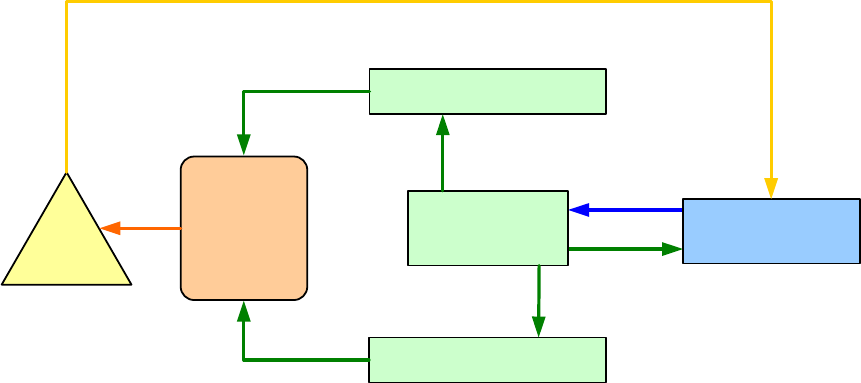
Rev 009C REVISED DOCUMENT
2/1/2007 30
PROGRAM FILTER SELECTIONS
Load Filter
Select
Back Program Filters
Program Filter #1
Program Filter #1
List of
Choices
Load
Select
Select
Select
Troubleshooting
All cables should be checked for shorts and opens.
The rooftop antenna (Donor Antenna), if directional, should be checked for proper alignment along the calculated
compass heading. Typically, the directional antenna should be aimed at the same site that your handset uses in the
area where the outside antenna is placed.
If cables and alignment are acceptable, it may be necessary to use a spectrum analyzer to examine the signal
environment in which the FAR is operating. The existence of strong analog signals within the frequency bands can
cause the AGC to reduce the amplifier’s gain particularly on the downlink. In some cases additional filtering might be
required to reject these unwanted signals. In some instances the directional outside antenna can be reoriented,
horizontally to place the interfering source in an antenna pattern “null”. There also may be some cases where the
interference from outside signals is so great that they cannot be filtered or otherwise reduced or eliminated without
expensive and possibly prohibitive measures. In these cases it may not be practical to use the FAR for providing
coverage at these sites.
Rev 009C REVISED DOCUMENT
2/1/2007 31
APPENDIX A
Event Types and LCD Display and LED color:
None "-----" None
LogStarted "START" None
Oscillation "OSC" Yellow
Overrange "RANGE" Red
Overheat "HEAT" Yellow
Undertemp "TEMP" Yellow
FanFailure "FAN" Yellow
Overcurrent "PA HI" Red
Undercurrent "PA LO" Red
DacPllLock "DAC" Red
LoPllLock "LO" Red
FilterLoad "FPGA" Red
SwAbort "SFTWR" Red
Overpower "INPWR" Red
Event Labels and LCD Display:
None "---"
Set "SET"
Clear "CLR"
Transient "TR"
Local "LC"
Event Targets (originator) and LCD Display:
None "--"
Chassis "CS"
PowerSupply "PS"
Motherboard "MB"
Dnlink "DN"
Uplink "UP"
Controller (SBC) "CT"
PowerAmp "PA"
Software "SW"
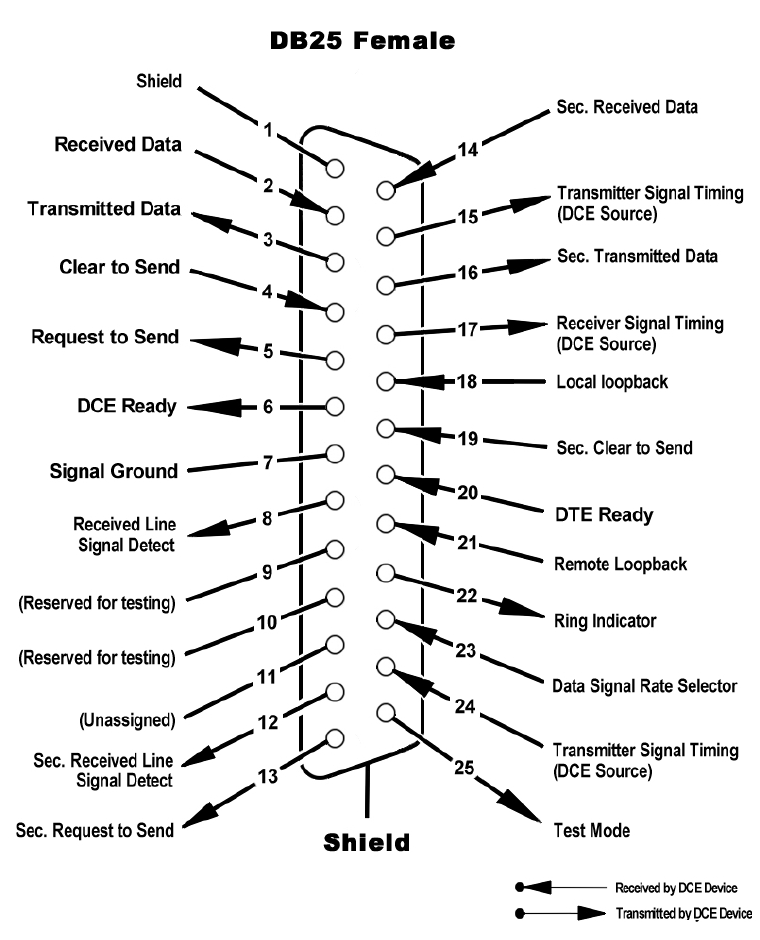
Rev 009C REVISED DOCUMENT
2/1/2007 32
Appendix B
Communication Protocol
EIA Specification
Note: The above diagram is provided as additional reference should adaptation be required.
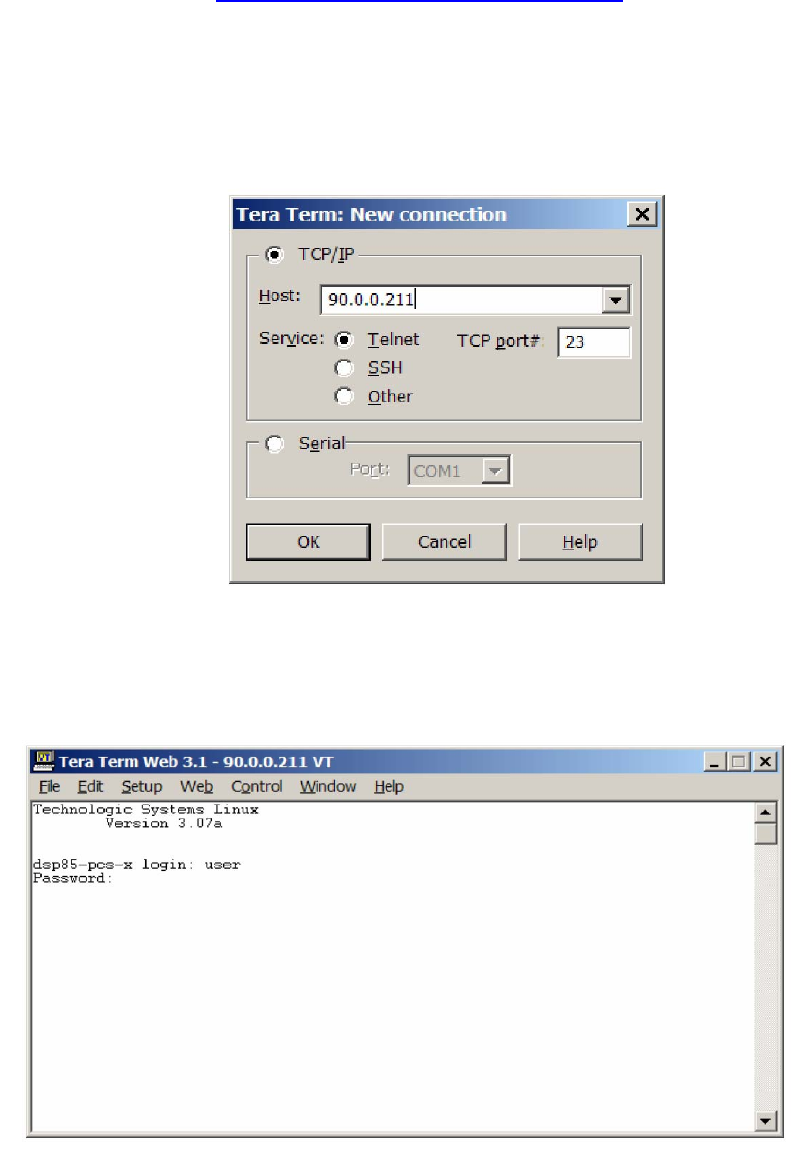
Rev 009C REVISED DOCUMENT
2/1/2007 33
Telnet Session(Remote Access)
Remote access to the repeater can be gained thru a LAN connection using Telnet, a terminal
emulation program for TCP/IP. Any terminal emulation program will work if properly configured. In
the following description, “Tera Term” is used to establish the telnet session. This program is
readily available via the internet and is free from Ayera Technologies at:
http://www.ayera.com/terayerm/download.htm
When the program is started, the following screen is displayed. Change the default host IP
address to the IP address of the repeater to be controlled. The IP address can be found in a sub-
menu under “Show ID” (See page 18). The address 90.0.0.211 has been assigned in this
example. Port 23 is an acceptable default port and Telnet must be selected.
Pressing “OK” will establish a connection to the repeater if it has been connected and been given
a transport pathway (inter/intranet access). A login and password screen will be presented. The
default login is “user” (all lower case letters) and the password is “csi1234” (also all lower case).
The login sequence is time sensitive.
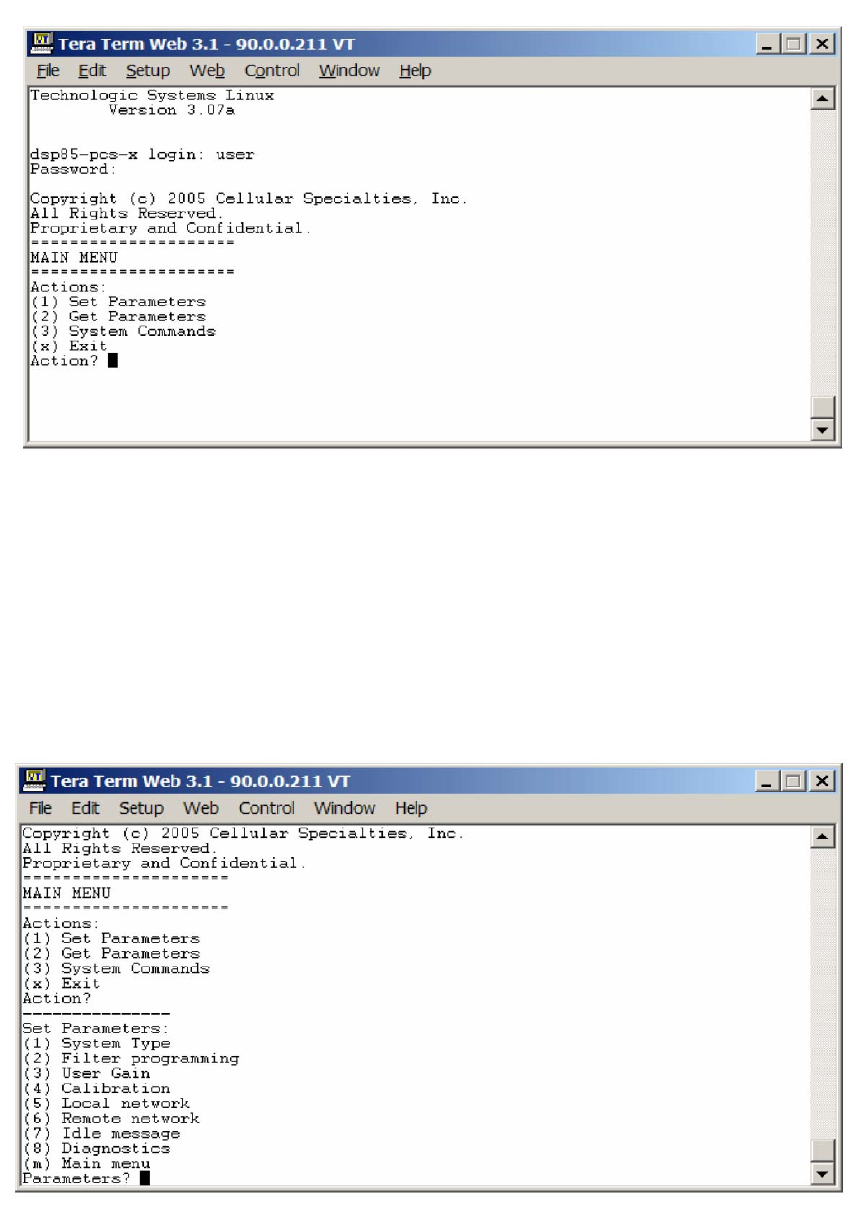
Rev 009C REVISED DOCUMENT
2/1/2007 34
A successful login will provide the following screen:
Set Parameter Commands
The four actions displayed are self-explanatory. Pressing “1” will continue to expand the session
screen and allow the following SET parameters to be entered.
Each “Set parameter” can be expanded to gain access to the information category described.
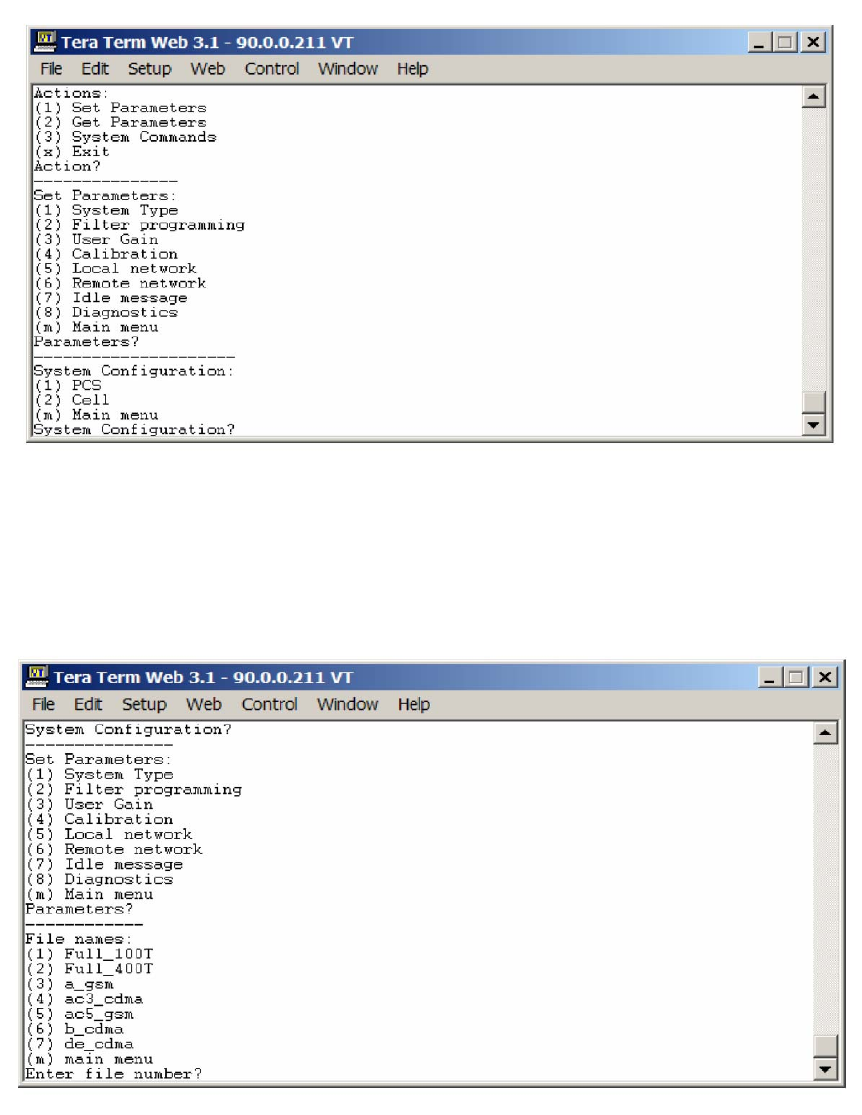
Rev 009C REVISED DOCUMENT
2/1/2007 35
“System Type”(1) selects whether the unit is PCS or Cell enabled. The selection must match the
hardware; PCS hardware cannot be made to operate at cellular frequencies. (m) will move up
one level.
“Filter Programming” (2) displays the filter files that have been stored into memory. Each file
contains the coefficients necessary to program the FPGA such that its response produces the
desired passband.
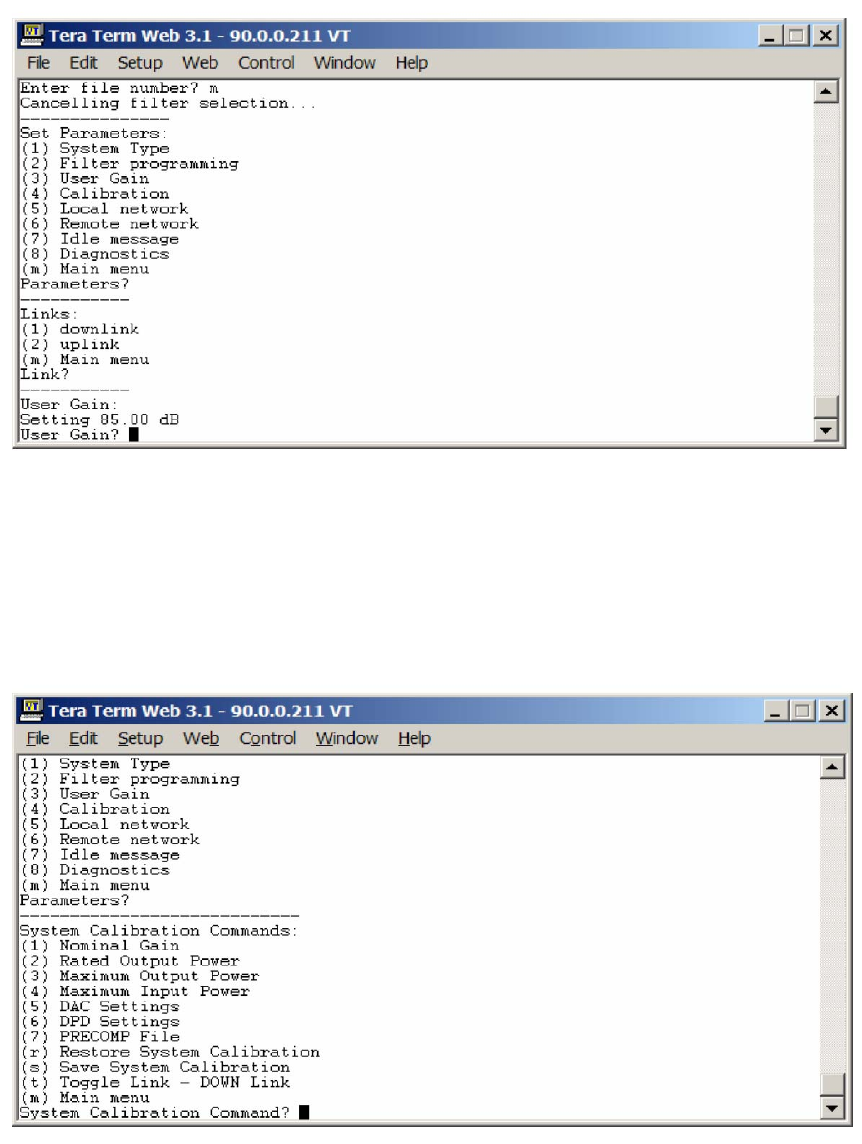
Rev 009C REVISED DOCUMENT
2/1/2007 36
“User Gain”(3) will offer downlink and uplink as choices. Selecting either link will display the
current gain and offer the opportunity to change the gain on that link. 85.00dB is the example
used. Inserting the same or different gain setting will move the menu up one level.
“Calibration”(4) will offer a set of system calibration commands. These commands are used to
calibrate the unit at the factory or at a facility having proper test equipment. They should not be
changed in the field unless instructed by the factory.
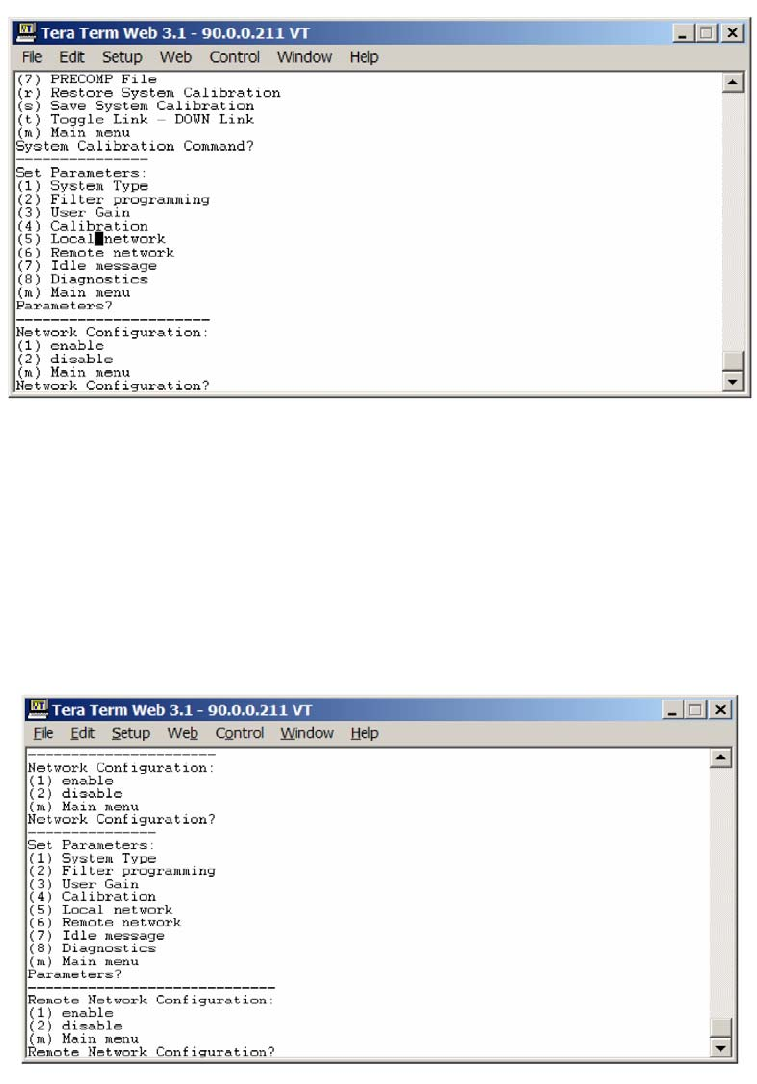
Rev 009C REVISED DOCUMENT
2/1/2007 37
“Local Network”(5) will allow local network access to be enabled (1) or disabled (2). The
network must be enabled thru a Command Line Interface (CLI), otherwise known as the console
interface, if said network is disabled. This interface is accessed thru serial port “Com1”.
“Remote Network Configuration”(6) can be used to establish remote access thru a modem
installed in the unit.
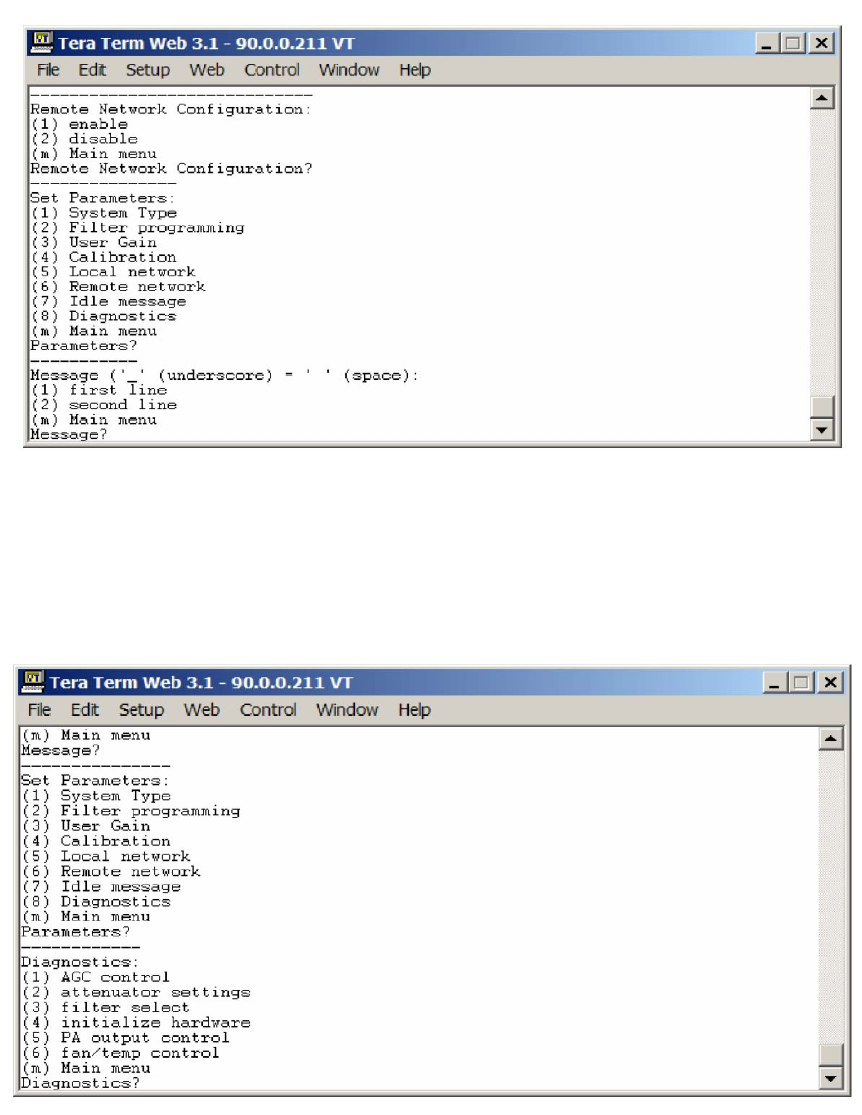
Rev 009C REVISED DOCUMENT
2/1/2007 38
“Idle Message”(7) refers to the screensaver message displayed after the keypad has been idle
for a period of time. A default screensaver is stored in the unit to speed intial identification of the
hardware capabilities. After installation, it may be desirable to provide the unit with unique
network identification.
“Diagnostics”(8) offers a list of tools used to determine the health of the system. AGC (1) will
allow the AGC to be turned “OFF” or “ON”. This should never be done except in rare
circumstances and only by qualified personnel who understand the nature of the RF environment.
Attenuator settings (2) are normally under AGC control and cannot be manually changed unless
AGC is disabled.
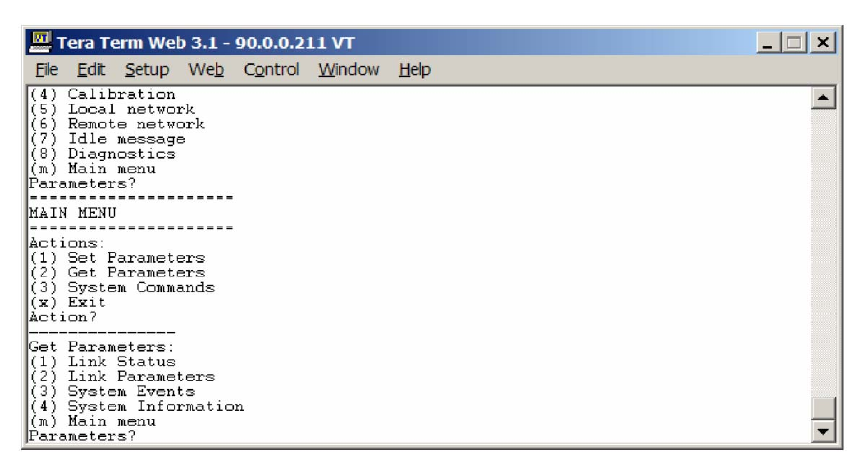
Rev 009C REVISED DOCUMENT
2/1/2007 39
Filter Select (3) will allow the filter to be set from parameters loaded into EEPROM #1 or #2.
Additionally, three specialized functional tests can be invoked.
Hardware initialization (4) is equivalent to a soft re-boot.
PA Output Control (5) allows the PA to be enabled or disabled. Actually, the gain is reduced to an
insignificant level.
Fan/Temp Control (6) allows the fan and temperature control settings to be manipulated.
Get Parameter Commands
Pressing “2” will provide access to GET commands.
“Linkn Status” (1) provide a snapshot of information about the Up and Down links at the time
the selection is pressed.
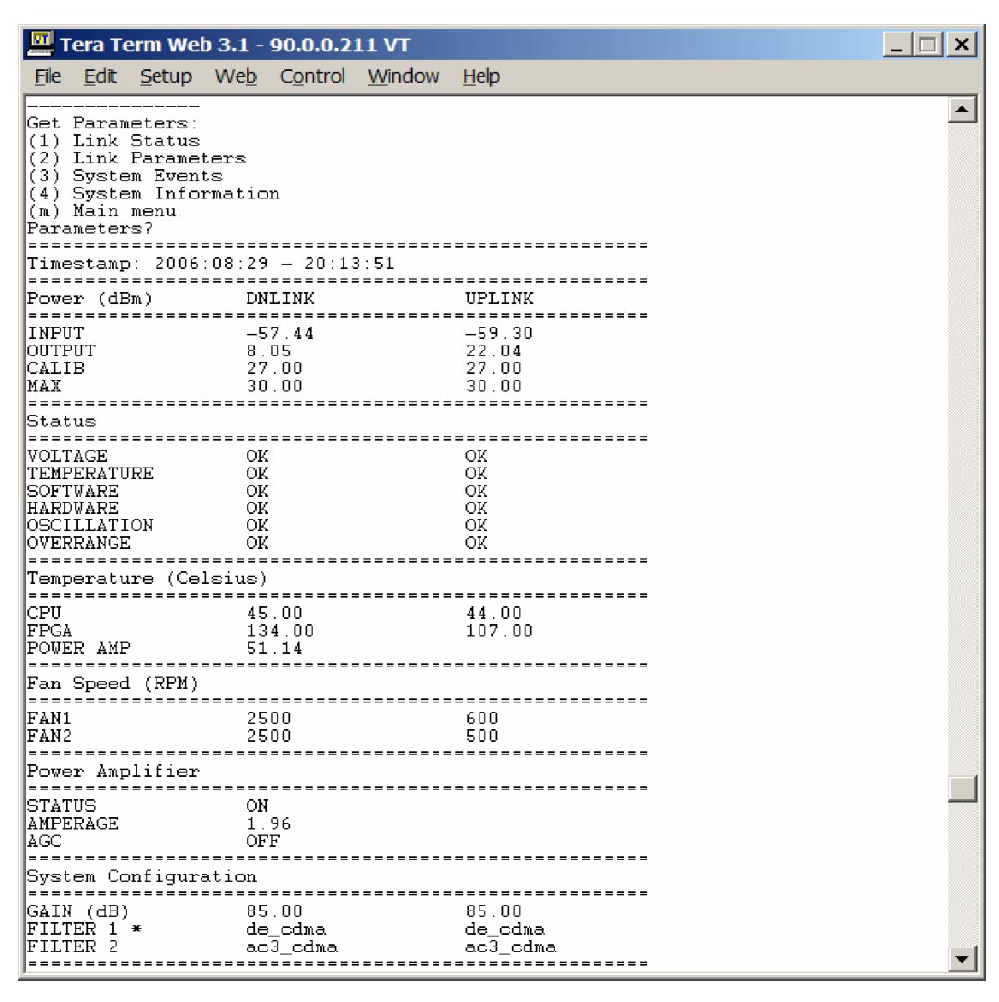
Rev 009C REVISED DOCUMENT
2/1/2007 40
“Link Parameters” (2) will likewise provide a snapshot view of the parameters used on both the
Up and Down links.
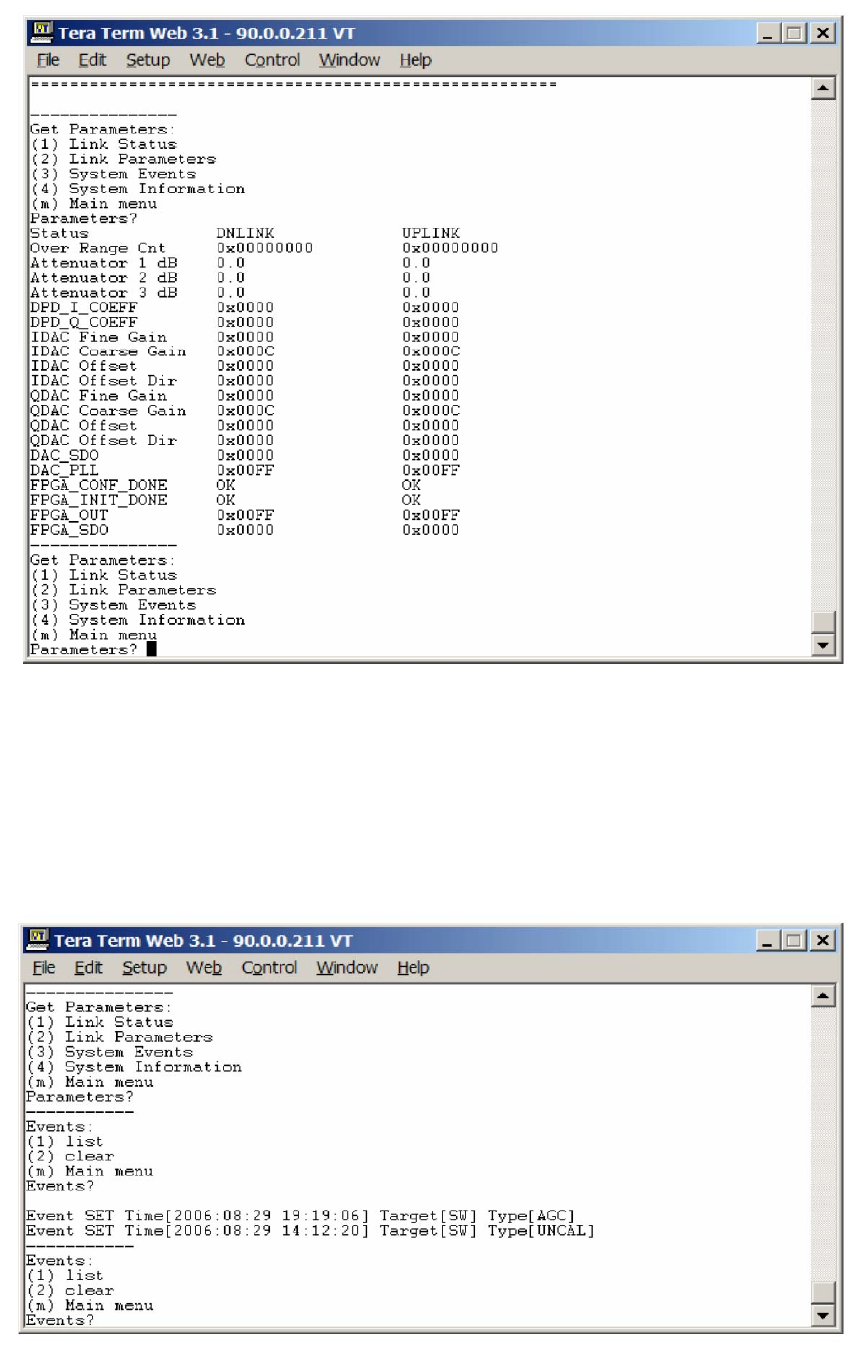
Rev 009C REVISED DOCUMENT
2/1/2007 41
“System Events” (3) This command will list the events that have occurred over time. Up to 100
descriptions and system times will be displayed with the oldest event falling off the register as a
new event occurs (LIFO). The events register will initially not show any events until the list
command is used. The clear command can be used to clear the register for fresh iinformation if
desired.
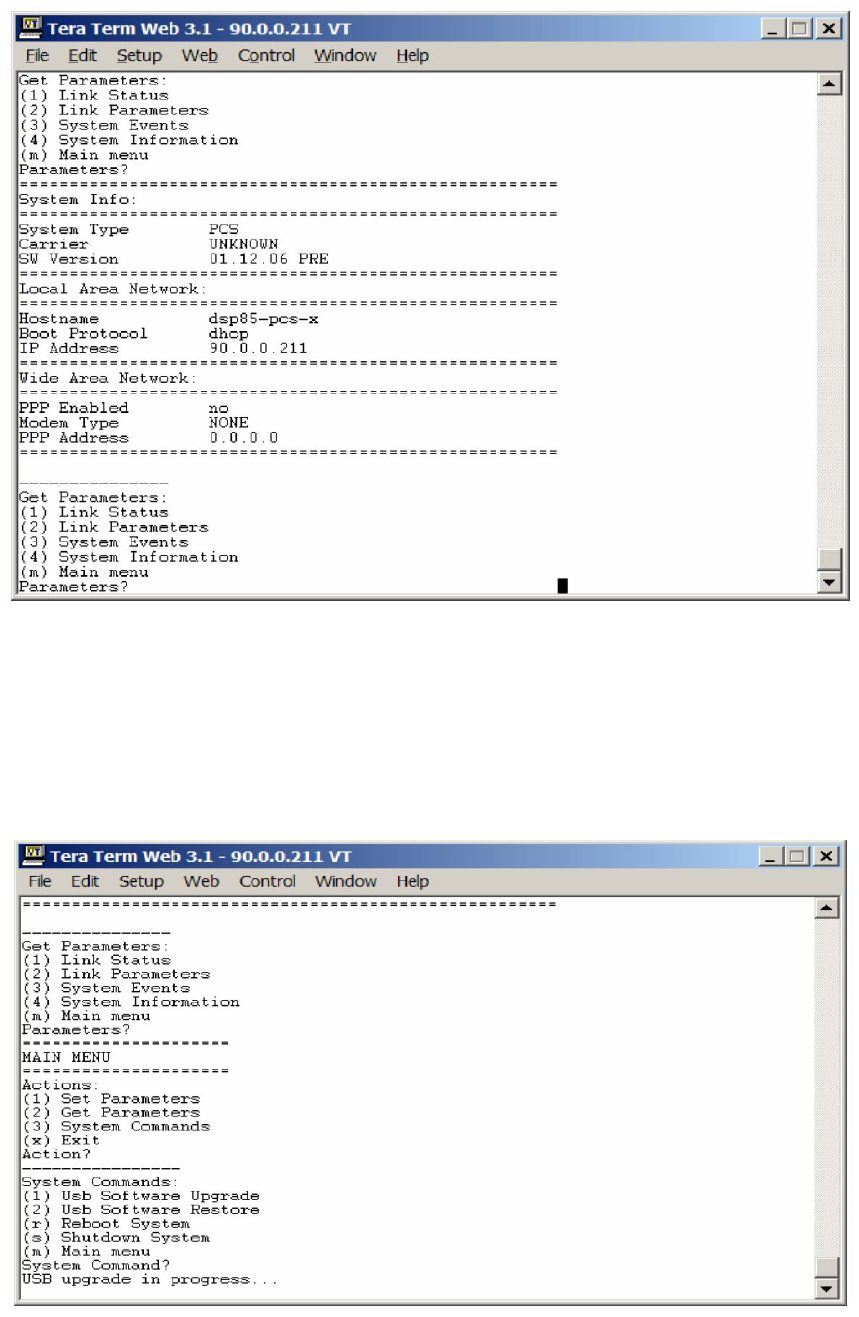
Rev 009C REVISED DOCUMENT
2/1/2007 42
“System Information” (4) can be used to get high level information about the system such as
F/W version and assigned IP address.
System Commands
System commands are self-explanitory. Precaution should be taken not to invoke a USB
Software Upgrade or Software Restore unless a USB key is installed. If this mistake occurs, the
Telnet session will lock up and further commands will not be recognized until the unit is switched
off and then on to force a hard re-boot, or the proper USB key is inserted.
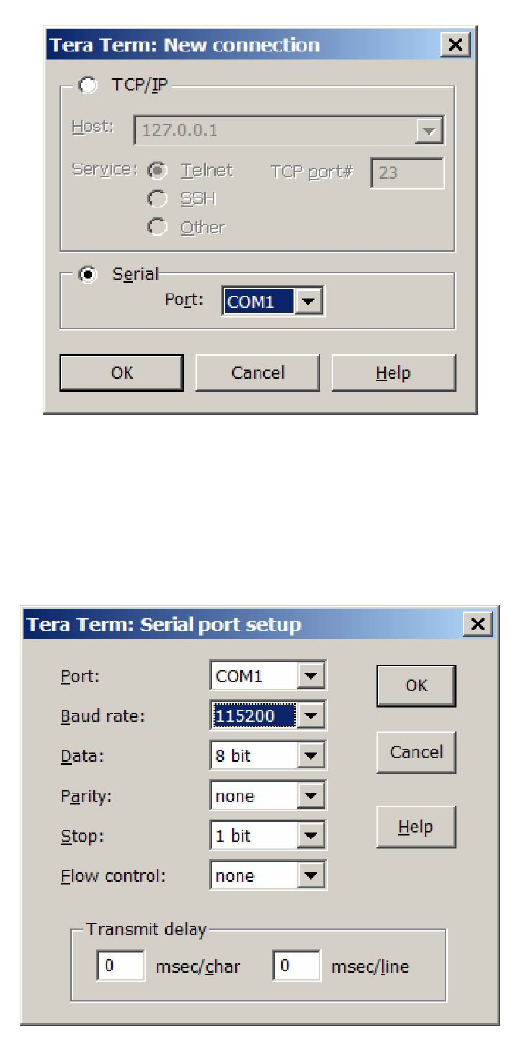
Rev 009C REVISED DOCUMENT
2/1/2007 43
Re-booting the system (r) will disconnect the session. Login must be reinitiated after the system
has had time to reinitialize.
Shutting down the system(s) will require the system to be switched off and then on agaiin in order
to re-start the system. This cannot be accomplished remotely.
Command Line Interface (Local Access, Non-login)
Local access to the Command Line Interface (CLI), also known as the console interface, is made
through com port 1 using a null modem serial cable. A terminal emulation program is also
required, however, it’s configuration will be different.
Configure the terminal program for Com 1 and 115200 baud rate as shown below. Pressing “OK”
will open up a blank dialog screen. Go to the setup/serial dropdown screen to make changes to
the serial port setup.
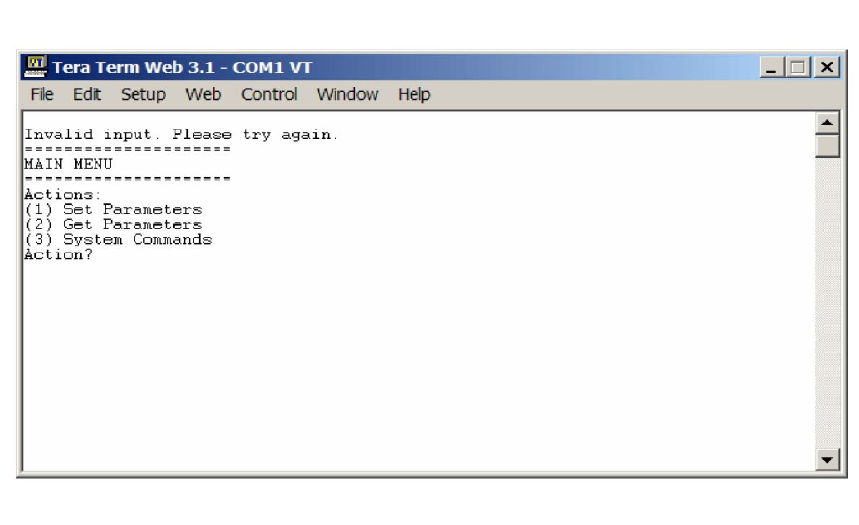
Rev 009C REVISED DOCUMENT
2/1/2007 44
After completing the serial port changes, a blank screen will appear. After pressing return the first
CLI dialog will begin. No login sequence is required as in the LAN port telnet session. It is
assumed the physical security of the port is adequate.
Note: Graceful session termination is important. Use Disconnect under the file drop-down menu
to terminate a session, otherwise the port may become disabled and force the system to be re-
booted.
The menu items presented during local access thru com port 1 are identical to a LAN port
session.
Modem Interface (Remote Access with Login)
A modem can also be used to gain remote access to the unit provided the repeater has been
properly equipped. A selection of modems is available as an option that must be installed at the
factory. Additionally, if the modem requires a SIM card for activation, the card must be added to
the repeater before site installation and operation. Special requirements must be met for the SIM
card to become fully functional.
Once the modem has been installed and activated, it can be accessed from any terminal
emulation program just as in the LAN and con port 1 examples provided earlier. Access response
time will depend on many factors, some of which are:
• Quality of the connection (RF signal in the case of wireless modems)
• Technology (CDMA, EDGE, GPRS, etc.)
• Network congestion (Thruput)
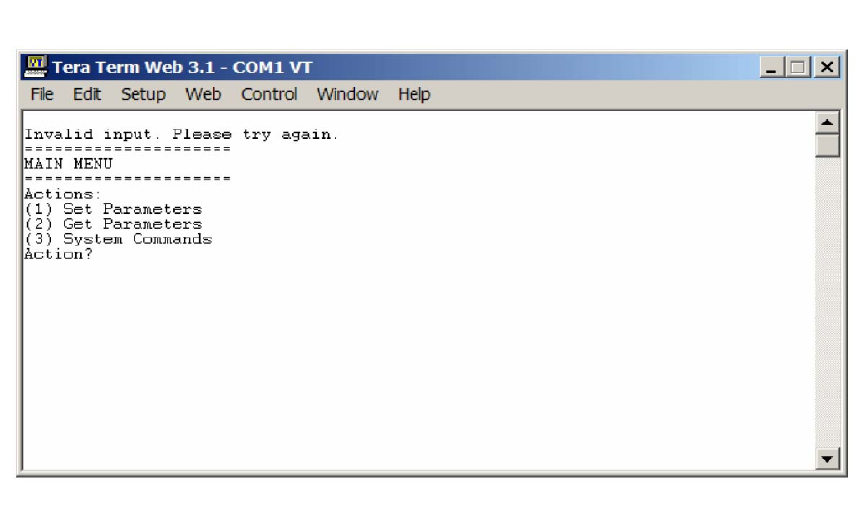
Rev 009C REVISED DOCUMENT
2/1/2007 45
Once a connection has been established, the following Login screen is presented:
The login will be echoed back to the terminal screen, however, as in all cases the password
response is not echoed. The menu screens presented in the modem interface mode are identical
to the previous two modes.
Rev 009C REVISED DOCUMENT
2/1/2007 46
One Year Limited Warranty
Seller warrants that its products are transferred rightfully and with good title; that its products are free from
any lawful security interest or other lien or encumbrance unknown to Buyer; and that for a period of one year
from the date of installation or fifteen months from the date of original shipment, whichever period expires
first, such products will be free from defects in material and workmanship which arise under proper and
normal use and service. Buyer’s exclusive remedy hereunder is limited to Seller’s correction (either at its
plant or at such other place as may be agreed upon between Seller and Buyer) of such defects by repair or
replacement at no cost to Buyer. Transportation costs in connection with the return of products to Seller’s
plant or designated facility shall be paid by Buyer. The provisions of this warranty shall be applicable with
respect to any product which Seller repairs or replaces pursuant to it. SELLER MAKES NO WARRANTY,
EXPRESS OR IMPLIED, OTHER THAN AS SPECIFICALLY STATED ABOVE. EXPRESSLY EXCLUDED
ARE THE IMPLIED WARRANTIES OF MERCHANTABILITY AND FITNESS FOR PURPOSE. THE
FOREGOING SHALL CONSTITUTE ALL OF SELLER’S LIABILITY (EXCEPT AS TO PATENT
INFRINGEMENT) WITH RESPECT TO THE PRODUCTS. IN NO EVENT SHALL SELLER BE LIABLE FOR
SPECIAL, CONSEQUENTIAL OR INCIDENTAL DAMAGES, INSTALLATION COSTS, LOST REVENUE
OR PROFITS, OR ANY OTHER COSTS OF ANY NATURE AS A RESULT OF THE USE OF PRODUCTS
MANUFACTURED BY THE SELLER, WHETHER USED IN ACCORDANCE WITH INSTRUCTIONS OR
NOT. UNDER NO CIRCUMSTANCES SHALL SELLER’S LIABILITY TO BUYER EXCEED THE ACTUAL
SALES PRICE OF THE PRODUCTS PROVIDED HEREUNDER. No representative is authorized to assume
for Seller any other liability in connection with the products.
Industry Certifications/Registration Numbers:
FCC: NVRCSI - DSP85 - 1W - P
FCC: NVRCSI - DSP85 - 1W – C
FCC: NVRCSI – DSP85 – 1W – S
IC: 4307A – DSP85 – 1W – P
IC: 4307A – DSP85 – 1W – C
IC: 4307A – DSP85 – 1W – S